Ursa Major model. How to draw a constellation
Constellation Ursa Major (URSA MAJOR) ) is located in the northern hemisphere of the sky.
Its seven stars make up the most famous figure in the sky - ladle. With its two outermost stars Dubhe (a Ursa) And Merak (b Ursa) the bucket gives direction to North Star . In 1603 German astronomer Johann Bayer published an atlas "Uranometry" . In it, he first designated the stars in Greek letters, including the stars of the Big Dipper from west to east in the direction of the star pattern. But Bayer violated the main rule, according to which the brightness of the stars must correspond to the Greek alphabet. An alpha star is the brightest, a beta is the second brightest, and so on.
So here it is. The brightest star in the constellation is Alioth (xi Ursa Major) .
The constellation also features the most famous double system - Mizar (Zeta Ursa Major)) – "horse" And Alcor (80 Ursa Major) – "rider". It is believed that the one who naked eye calmly distinguishes between these two stars and has sharp eyesight.
Ursa Major contains two spiral galaxies - M81, very similar to our Galaxy, and M101. There is a small one nearby galaxy M82 , in which a powerful explosion occurred several million years ago - by astronomical standards this is relatively recent! This event is very important for astronomers, as it allows us to judge the processes of formation of galaxies and planets.
Another interesting object is located in the constellation - Owl Nebula (M97) , which got its name because of its great resemblance to this bird.
Legend of the constellation Ursa Major
We owe the name of the constellation to Greek mythology. Once upon a time, forever young goddess Artemis she walked with a spear and bow in search of game through the mountains and forests. Following her were her maids and companions, each more beautiful than the other. But the most charming was Callisto. Zeus (in Roman mythology Jupiter) when I saw the girl, I fell in love with her at first sight. However, according to the established rule, the maids of Artemis had no right to marry. Then the ruler of Olympus resorted to a trick - he appeared before Callisto in the image of Artemis, thereby achieving his goal. Callisto gave birth to a son from Zeus Arcade. He grew up quickly and became an excellent hunter.
Zeus's wife Hera I was very jealous. Having learned about what had happened, she turned Callisto into a clumsy bear. After some time, Arkad wandered through the forest. Seeing the bear and not knowing that it was his mother, he shot at her with a bow. But calm down, my dear reader. Zeus constantly watched his beloved and deflected the flying arrow. He turned Arkad into a little bear cub and took him and his mother to heaven. Zeus turned Callisto into the constellation Ursa Major, and Arcade into the constellation Ursa Minor.
Ursa Major circles around the pole. Once a day she goes down to the sea to quench her thirst. After this, she rises up again, attracting the views of people and gods with her beauty.
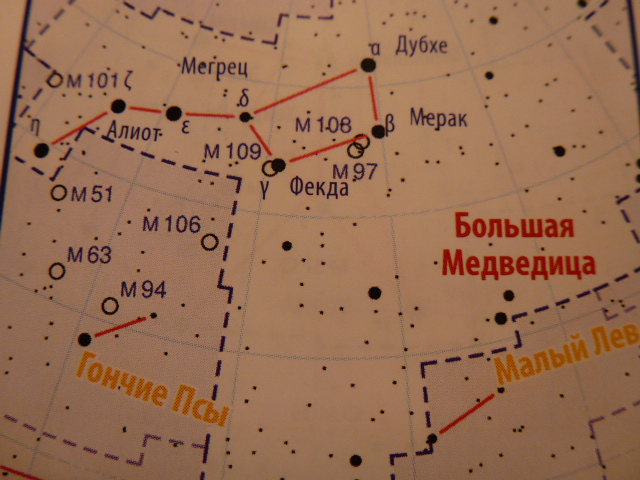
How to find the constellation Ursa Major in the sky?
This is probably a rhetorical question. Even in childhood, we all begin to study the starry sky by searching for the Big Dipper, the constellation is clearly visible throughout Russia. The best conditions for observation are in March and April. The topography of the constellation is as follows. Neighboring the Ursa Major is the constellation Giraffe, which has no bright stars. To the east of the bucket are clearly distinguishable Perseus and Cassiopeia. To the southeast is Bootes, with its bright star Arcturus.
To draw a constellation, you need to have at least a passing understanding of astronomy and mythology. Astronomy is needed in order to identify the so-called asterism in the depicted constellation - an established group of the brightest stars, which has a historical name. Mythology will come in handy when you select an image for a future drawing, because... The image of the constellations, to a greater or lesser extent, has been established for quite a long time.
You will need
- - pastel / colored pencils.
Instructions
Most constellations consist of small stars, which are therefore not included in the asterism. Usually they do not even have their own names, but are designated only by letters of the Greek alphabet. This means that they give neither outline nor meaning to the image of the constellation. However, if you are drawing a constellation, and not just a mythical character with some dots or lines, these small stars should also be noted in or near the drawing.
At the beginning, exactly those stars that make up the asterism are designated. But even this may not give the artist anything in terms of the idea of the drawing: for example, the asterism of the constellation Canes Venatici, near the Big Dipper, is represented by only two stars, which does not give the draftsman either an image or even a hint. But there are several galaxies and globular star clusters here, which will provide your imagination with more choice - you will be less bound by the mythological plot.
For example, the easiest way is to take something familiar from childhood and visible in the sky almost constantly. Although his drawing is not as clear as it might seem. The “Big Dipper” is familiar to many from the moment a person begins to get acquainted with starry sky. It is better known to the older generation as a reference point to the North Star. Its asterism is always visible in a clear sky, and all the names of the stars that make it up are known.
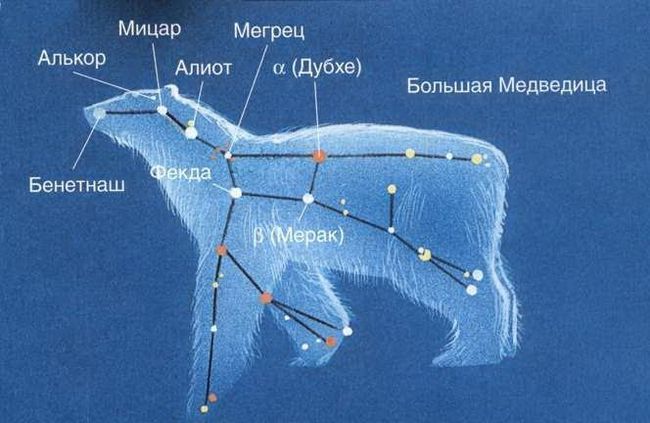
Note that the names of the stars are most often Arabic, and the mythology used to depict the constellations is usually European. But this will not stop you from creating your own, unique drawing of a constellation: you can choose the myth you like and follow its plot, or perhaps the constellation brings to you a completely different image, different from the known mythological ones - the main thing is that exactly those stars are reflected in your drawing , which are traditionally attributed to a specific constellation.
The ladle, also known as the Ursa Major asterism, is made up from the tip of the ladle by the stars Dubhe (alpha), Merak (beta, etc.), Phekda, Megrets, Aliot, Mizar (and Alcor(a)) and Benetnash. In addition, about two dozen more stars belong to the constellation Ursa Major. In the drawing you must reflect the exact location of the stars of the asterism, the rest is at your discretion: will you connect the stars with lines, will you reflect stellar magnitudes, will you show star systems in the drawing (such as Mizar and Alcor), will you draw dust clouds, nebulae , galaxies, etc. Actually, even those stars that will be “inside” are also your personal choice. However, if you decide to indicate other stars located outside the asterism, you must indicate their exact location, and possibly other characteristics if you used them when drawing the main stars.
Ultimately, you should include the constellation asterism in your drawing, but this does not mean that the drawing must necessarily be tied to the outline of the main stars. In Ursa Major, you can choose from at least two options: where the tip of the "ursa's" nose is represented by Dubhe or the star Benetnash. Oddly enough, the “handle of the dipper” of the Ursa is usually depicted as a long tail, and yet another fifteen stars turn out to be “unaccounted for.”
However, they are approximately equal in size to the Sun, and therefore are visible to the naked eye on the territory of the Russian Federation only occasionally and in certain geographical points. But this does not mean that they cannot be included in the constellation drawing! You should just stock up on a star map, which shows much more stars than can be seen in the northern hemisphere.
As for the image of the constellation itself, it is customary to draw only a slightly blurred outline of the figure, so that the meaning of the image is clear. Painting over a figure, drawing details, even a clear outline of a constellation is not accepted today: this kind of image of constellations is a tribute to the tradition of the Middle Ages.
A real treasure trove of interesting celestial objects. It’s impossible to list all its attractions - there are several dozen galaxies in the constellation alone that are accessible for observation with amateur telescopes! But there are also nebulae, double stars, star clusters... Here we invite your attention to get acquainted with the most important and - selectively - unusual objects of the Big Dipper. Look 50 photos.
The Big Dipper is the most famous asterism in the northern sky. This design is also often called the Plow or the Cart, and in India these stars are called the Seven Sages. In addition to the scoop, the image, compiled from 24 frames, also captured some famous deep space objects. In the upper right corner of the image is the orange star Dubhe - α of the constellation Ursa Major, to which the Bucket belongs. Together with the star β Ursa Major - Merak just below - they form a line pointing to the North Star and the North Celestial Pole (they are outside the picture). Someone has probably already noticed Mizar, the second star from the edge in the handle of the Ladle. Together with the seemingly close Alcor, they form a visual dual system, which can be used to test your vision. In addition, some famous Messier catalog objects can also be found in the photo. Photo: Rogelio Bernal Andreo/APOD
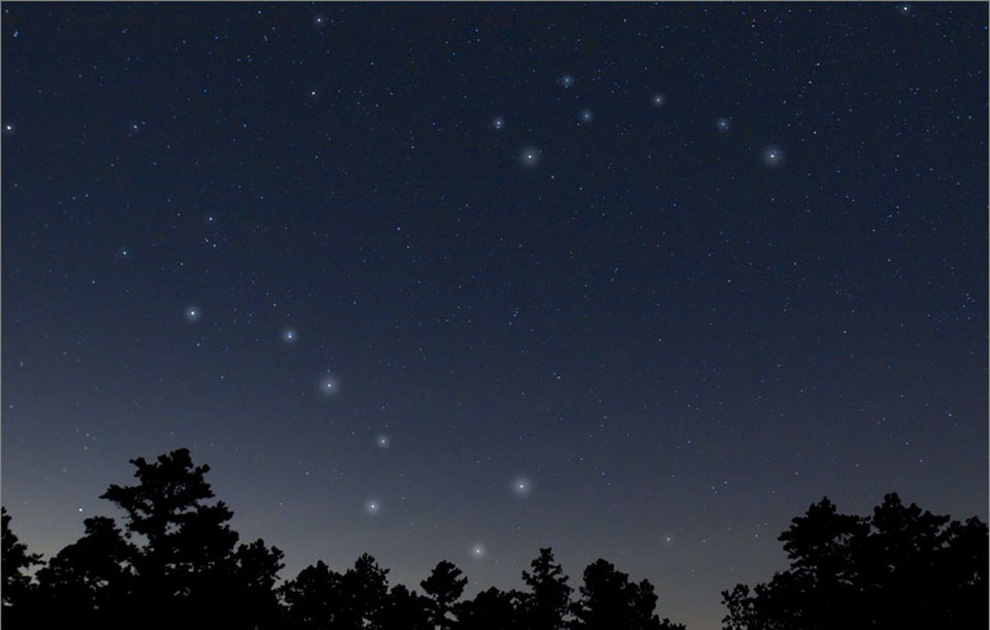
In addition to the Big Dipper, there is also a Small Dipper in the sky, at the end of which is the famous Polar Star. The Little Dipper is much more difficult to find than the Big Dipper, so in this illustration the brightness of the Dipper stars is artificially enhanced to distinguish them from the general mass of stars. How to find the North Star in this image? It’s very simple: connect the two outermost stars of the Big Dipper with a line and extend it upward. The line will point to the North Star. Photo: Jerry Lodriguss
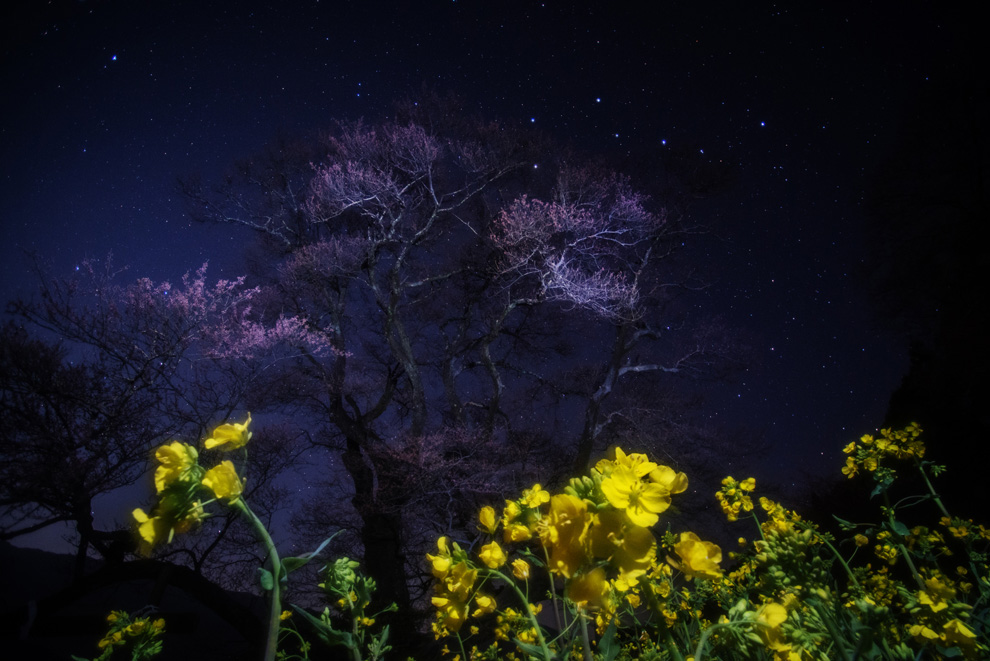
The Big Dipper is not a constellation, but an asterism that is part of the constellation Ursa Major. In spring and the first half of summer it is high in the sky in an inverted position. At this time it is often not noticed in the sky. But no matter what position the Big Dipper is in, its two outermost stars, Dubhe and Merak, always point to the North Star! This photo shows the scoop over cherry blossoms in the Japanese sky. Photo: Masahiro Miyasaka

Close to the equator, Ursa Major is no longer a non-setting constellation. In this image, the bucket sits low on the horizon, glinting above the vast Ngorongoro volcanic caldera in Tanzania. Photo: Yu Jun
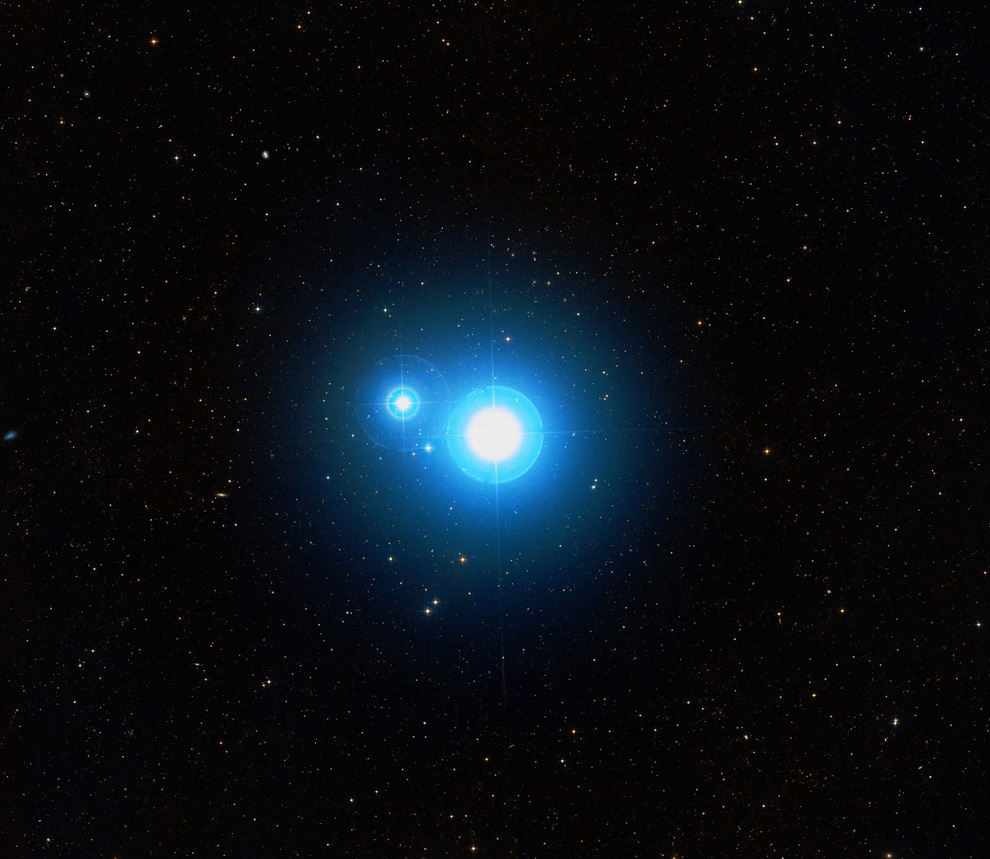
Mizar and Alcor are the most famous double star in the sky. This pair is located in the middle of the handle of the Ursa Major dipper. Photo: Sky-map.org
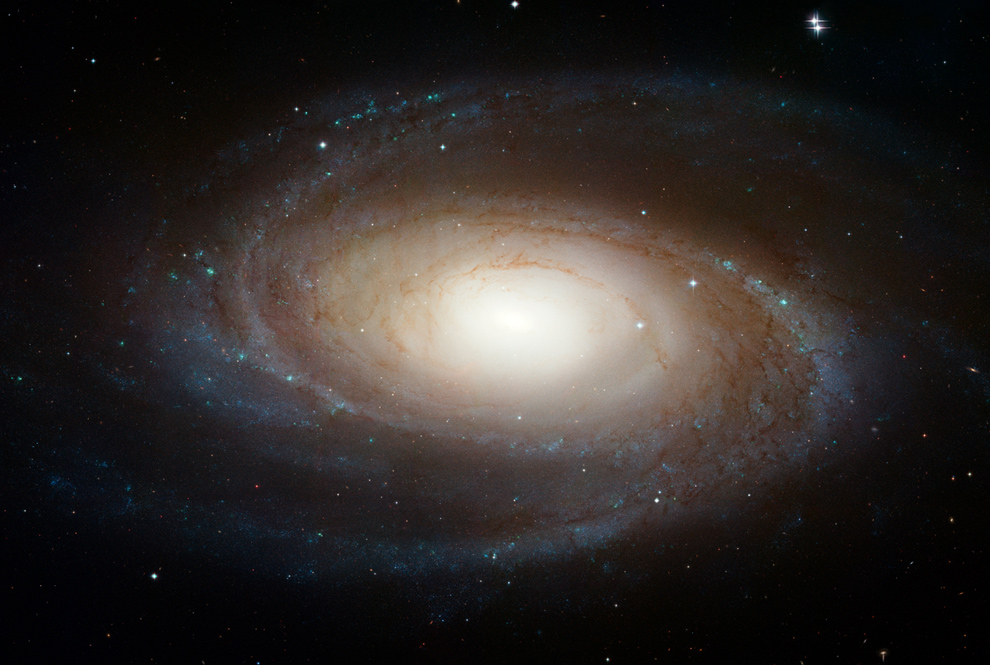
M81 is the brightest galaxy in the constellation Ursa Major - it is already visible through binoculars with an aperture of 50 mm. The M81 is similar in size to Milky Way. This classic photo was taken with the Hubble telescope in 2007. The image shows a lot of details: numerous star clusters in the arms of the galaxy, streaks of interstellar dust, clouds of hydrogen (artificially colored green in the image) and even some of the most bright stars! Photo: NASA, ESA, and The Hubble Heritage Team (STScI/AURA)
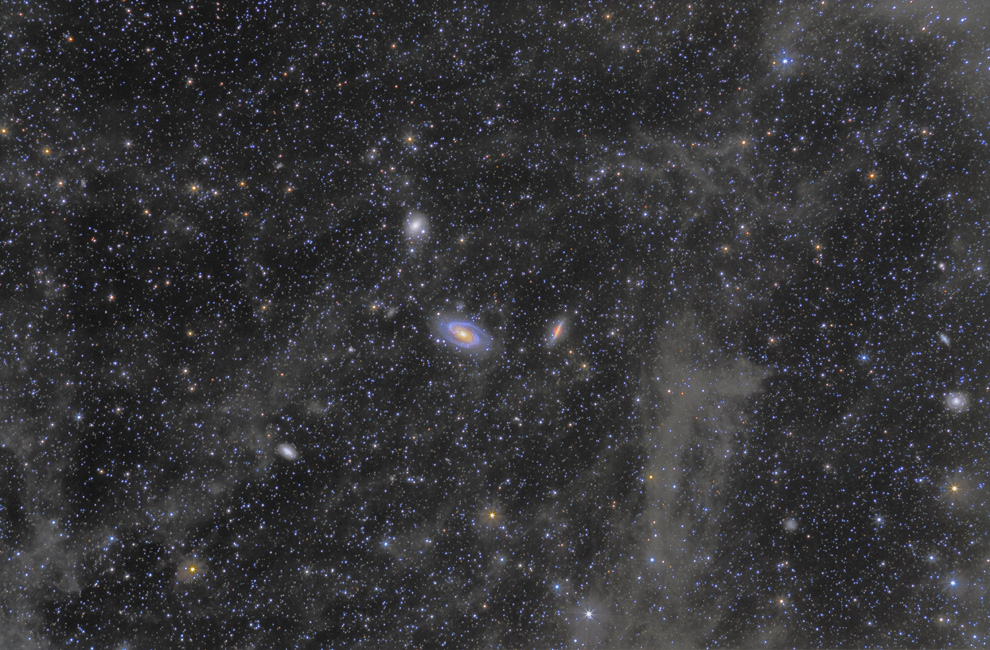
Wide-angle mosaics covering tens of square degrees show M81 and M82 among thin, faintly luminous gas clouds. These are high-latitude clouds belonging to the Milky Way. They are located above the disk of our Galaxy and are illuminated by the light of all the stars that make up the Milky Way. In this stunning image, high-latitude clouds form gray threads and filaments scattered throughout the image. The clouds are approximately 5-10 thousand times closer to Earth than the galaxies M81 and M82. Photo: Scott Rosen
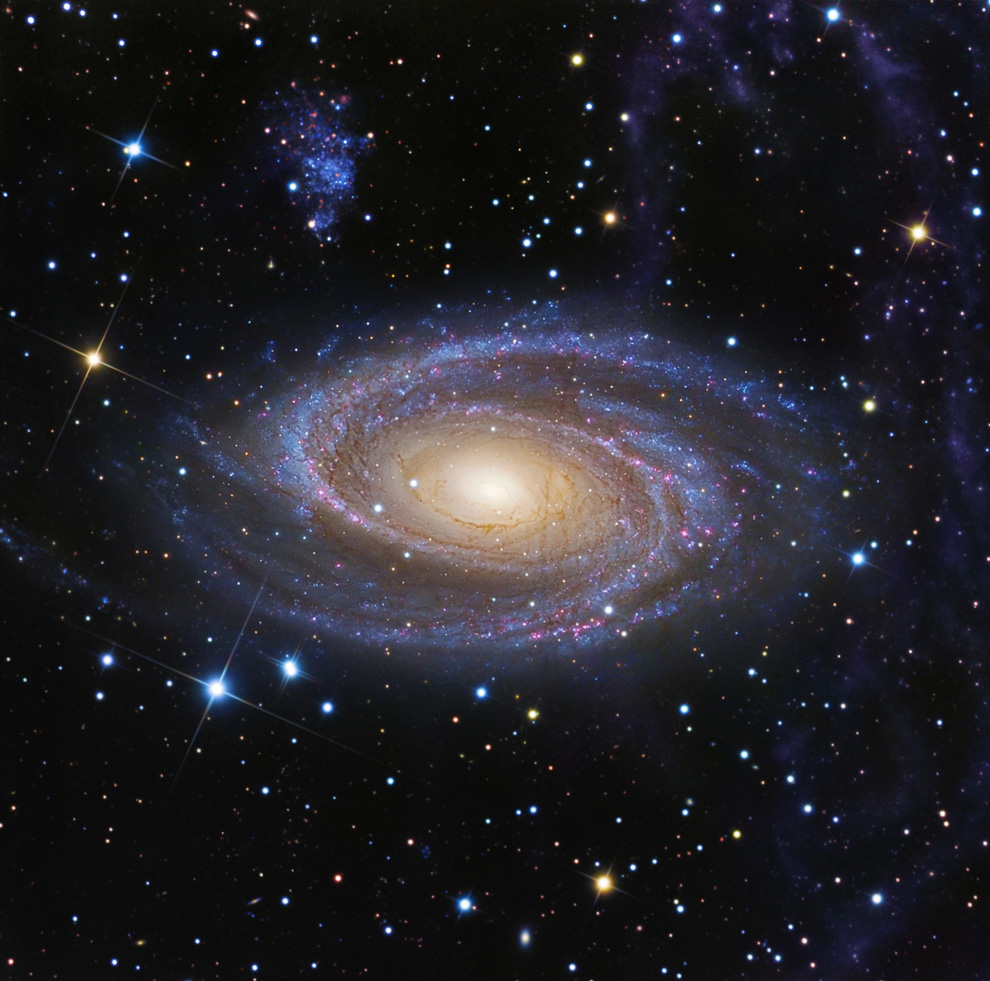
Arp's loop. Located 12 million light-years from Earth, M81, along with M82, NGC 3077 and NGC 2976, form one of the most famous groups of interacting galaxies. In 1965, astronomer Halton Arp noticed an unusual loop-like structure in photographs of M81, which he mistook for a tidal tail resulting from its approach to M82. (Located on the right side of the image.) However, newer research shows that Arp's loop is composed of dust and gas and is similar to galactic cirrus, clouds of interstellar gas above the plane of the Milky Way. In the photo you can also see an irregularly shaped spot above M81. This is the Holmberg IX dwarf galaxy, a satellite of M81. Photo: R. Jay GaBany
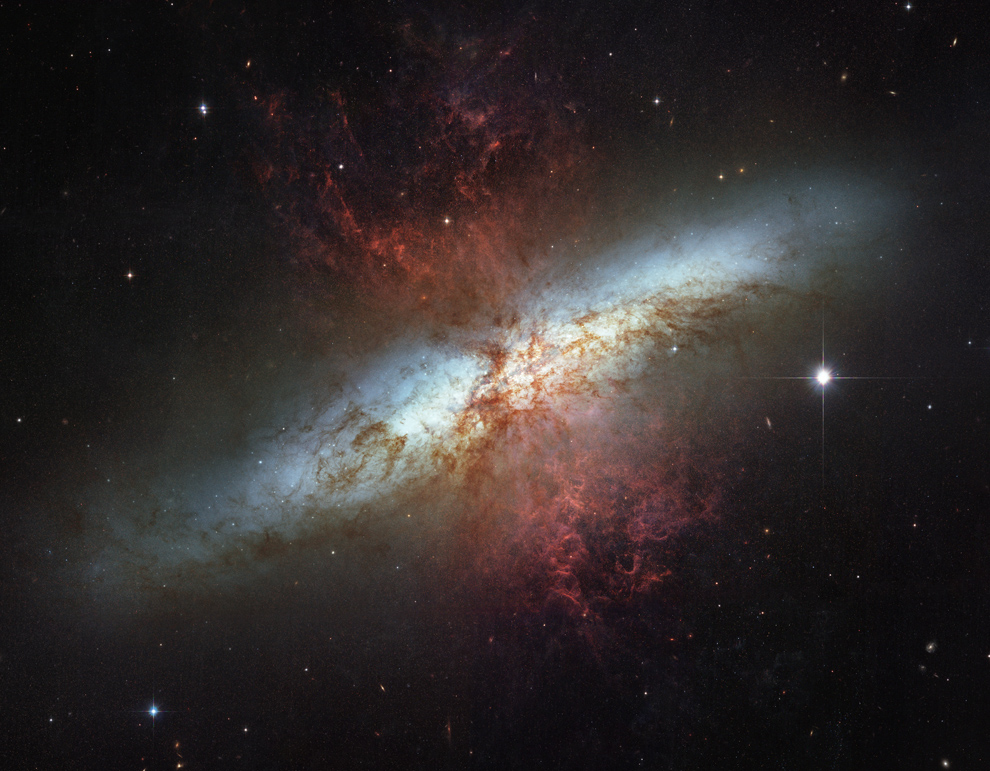
Galaxy M82 or Cigar Galaxy, a bright satellite of M81. For a long time, astronomers believed that a grandiose explosion had occurred in the center of M82 - spectral observations showed that interstellar gas was flying out from the center of M82 at a colossal speed of thousands of kilometers per second. In the image, cosmic gas M82 glows red. Recently, however, it was discovered that the gas is leaking out due to a "superwind" - the cumulative effect of stellar winds from the many newborn stars inside M82. All these stars were born almost simultaneously after the last close approach of M82 and M81. Photo: NASA, ESA
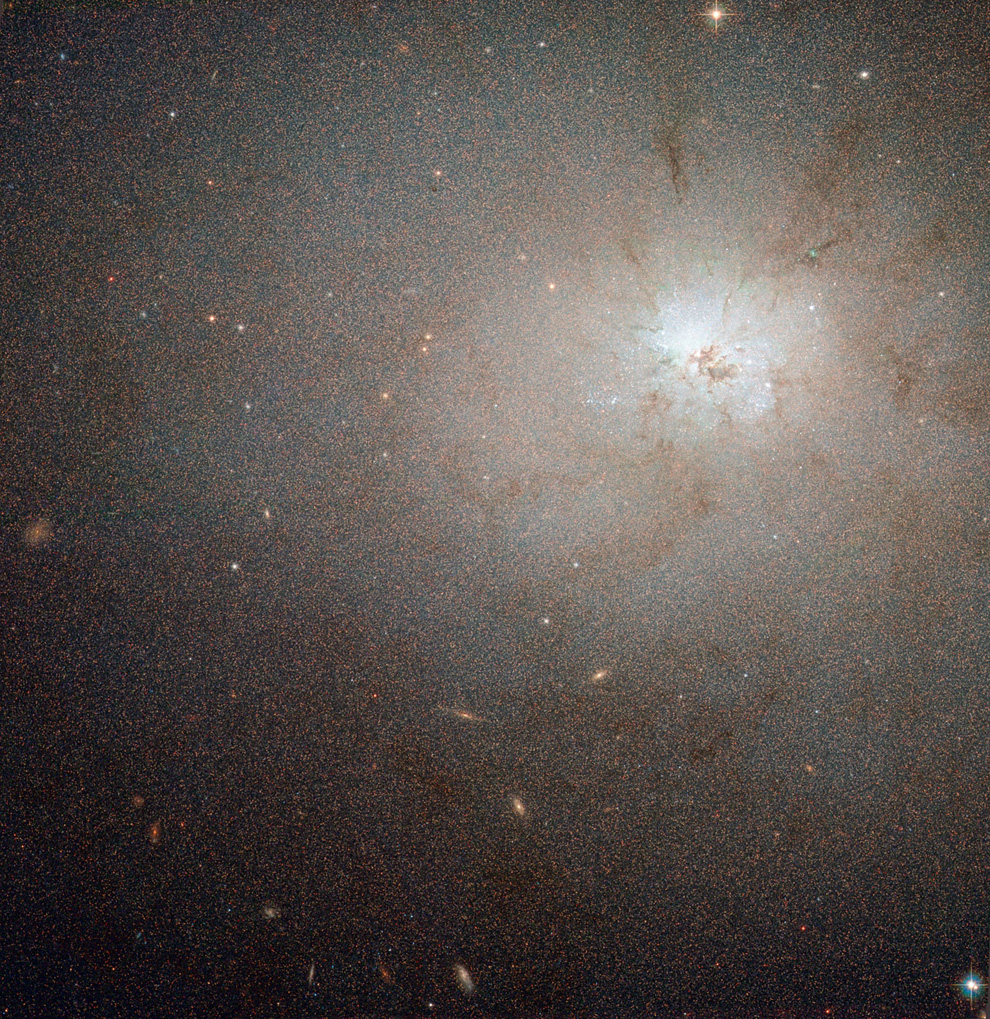
NGC 3077, a small elliptical galaxy, satellite of M81. It actively interacts (gravitationally) with the galaxies M81 and M82, as a result of which it looks very young and unusual for an elliptical galaxy: a mass of dust and bright young stars make up this image. Photo: ESA/Hubble & NASA
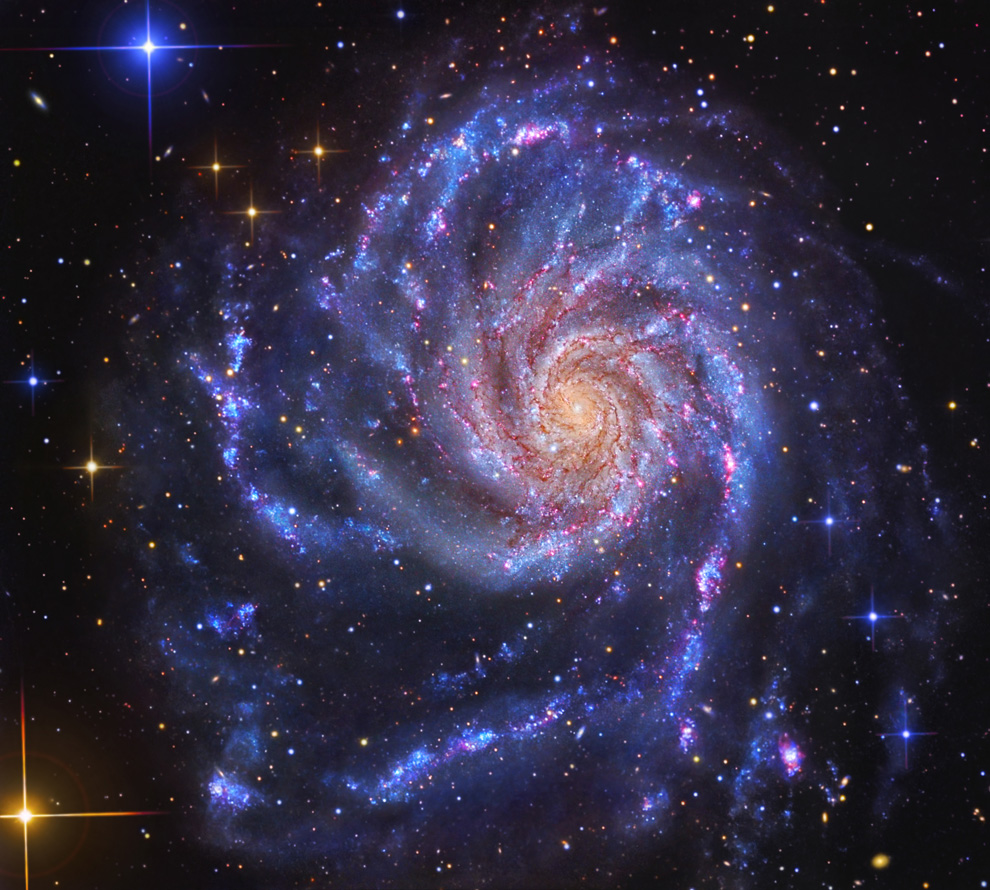
The luxurious spiral galaxy M101 is located near the pair of stars Mizar - Alcor and is visible even with good binoculars. Thanks to its characteristic structure, the M101 received the name “Turnable”. The distance to M101 is estimated at 27 million light years - it is 10 times further from us than the Andromeda Nebula. M101 is slightly smaller in size than the Milky Way, its diameter is 85,000 light years. Please note that the M101 helices do not extend from the nucleus, but from a small bridge crossing the small but quite bright nucleus. Photo: R. Jay GaBany
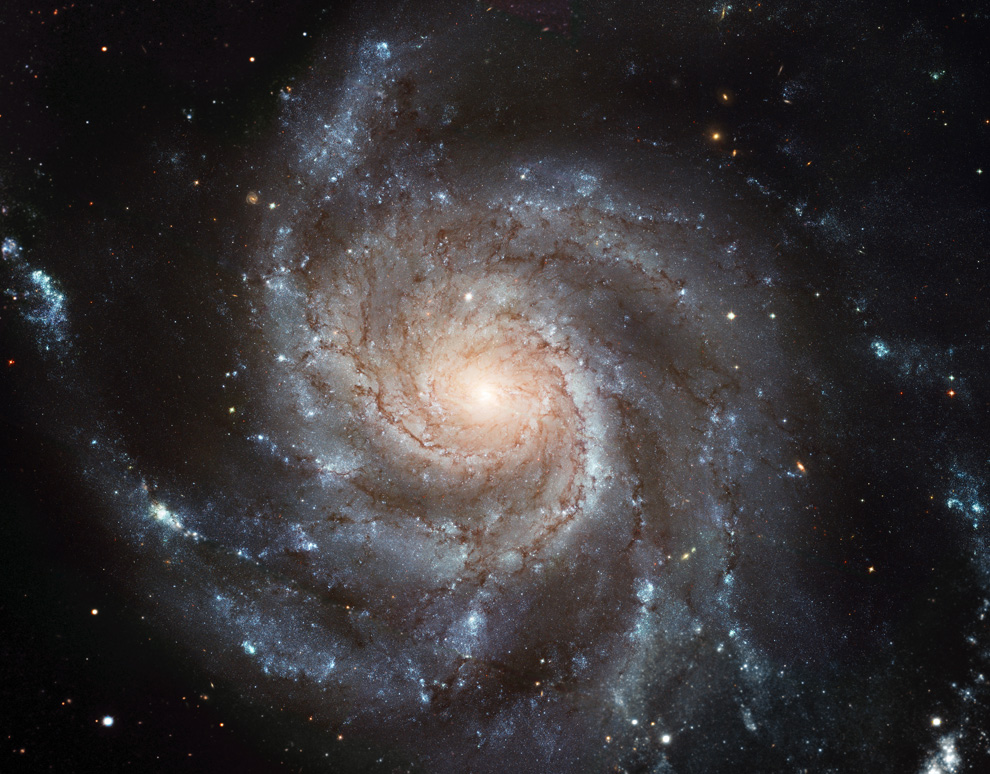
Galaxy M101. The mosaic is compiled from images taken by the Hubble Space Telescope in 2006. At that time, it was the largest and most detailed image of the galaxy taken using Hubble. Photo: European Space Agency & NASA
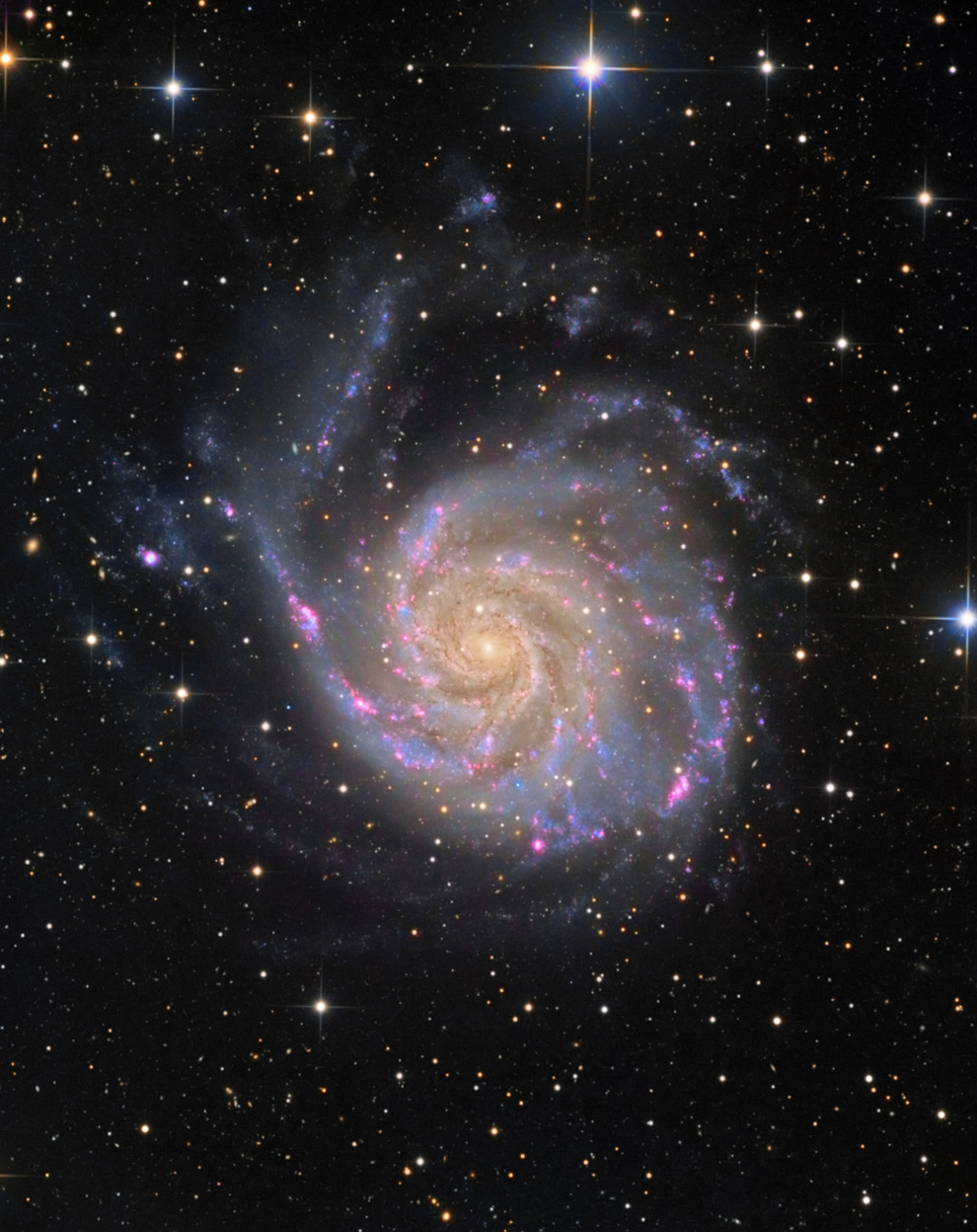
M101 contains many bright open clusters and hydrogen nebulae that form spiral arms. The clusters are dominated by hot and young blue stars. Nebulae heated by the ultraviolet glow of these stars glow red. The regions around the galactic core are populated by cooler and older dwarf stars like the Sun. Photo: Oleg Bryzgalov
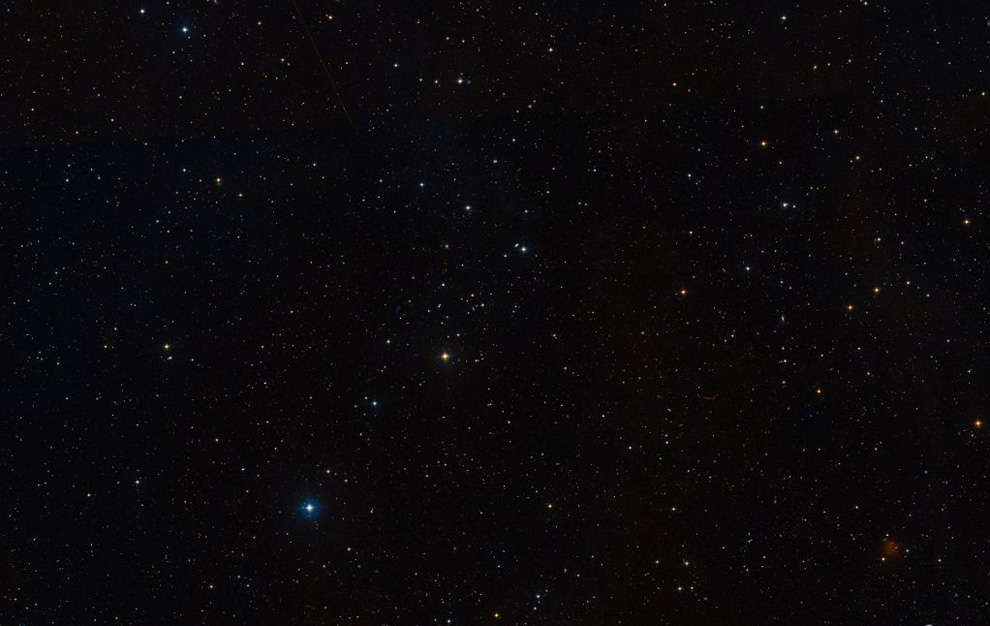
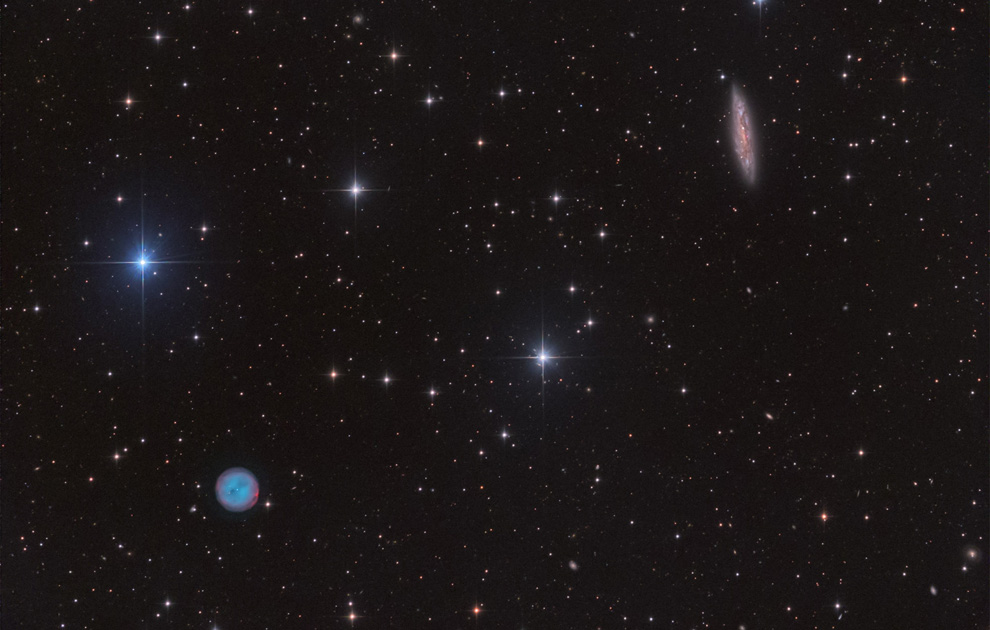
Owl and galaxy. In the vicinity of the star Megrets there are two Messier catalog objects: the planetary Owl Nebula (M97) and the spiral galaxy M108. Although these objects look like nebulous specks in small amateur telescopes, their nature is completely different. The Owl Nebula is an expanding shell of gas ejected by a star at its death. A tiny star is visible in its center. This is a super-hot white dwarf, the core of a dead star. M108 is a large spiral galaxy containing tens of billions of stars. The Owl Nebula is located 2600 light years away from us. Galaxy M 108 is almost 7000 times further away: light takes 14 million years to reach it! Photo: Christoph Kaltseis/APOD
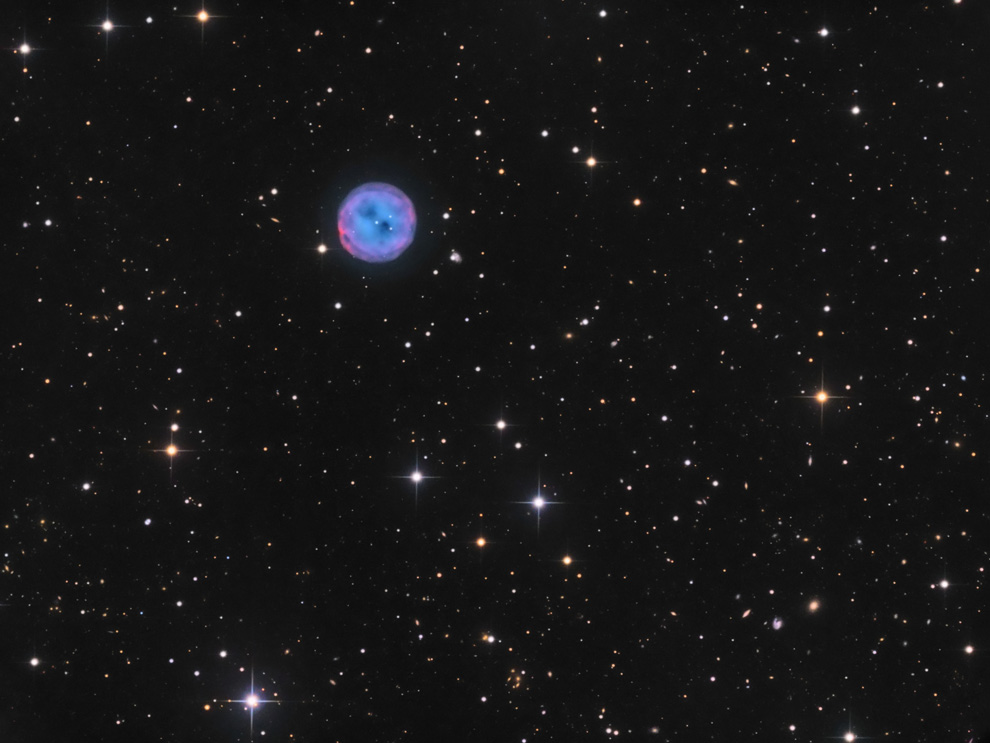
The Owl Nebula or M97 is a rather difficult object for amateur telescopes. The ghostly nebula is clearly visible only far outside the city, in a dark and transparent sky. You will be amazed at how much it resembles an owl! This is one of 1600 planetary nebulae, known in our Galaxy. In total, according to astronomers, there are about 10 thousand such nebulae in the Milky Way. Photo: Oleg Bryzgalov
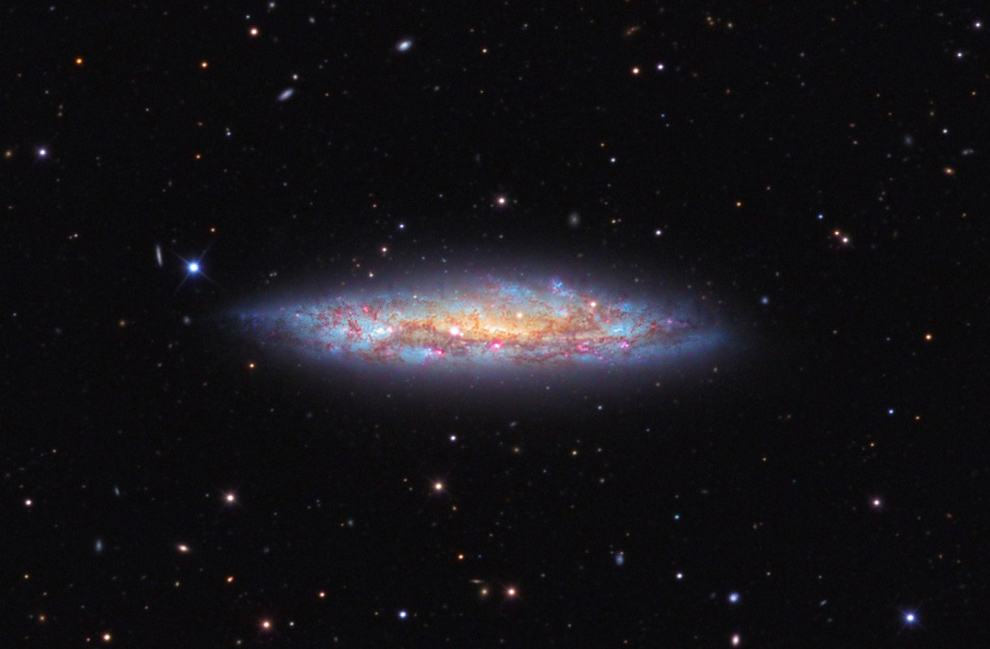
Galaxy M108 (NGC 3556) is a crossed spiral that we observe almost edge-on! Photo: Ken Crawford
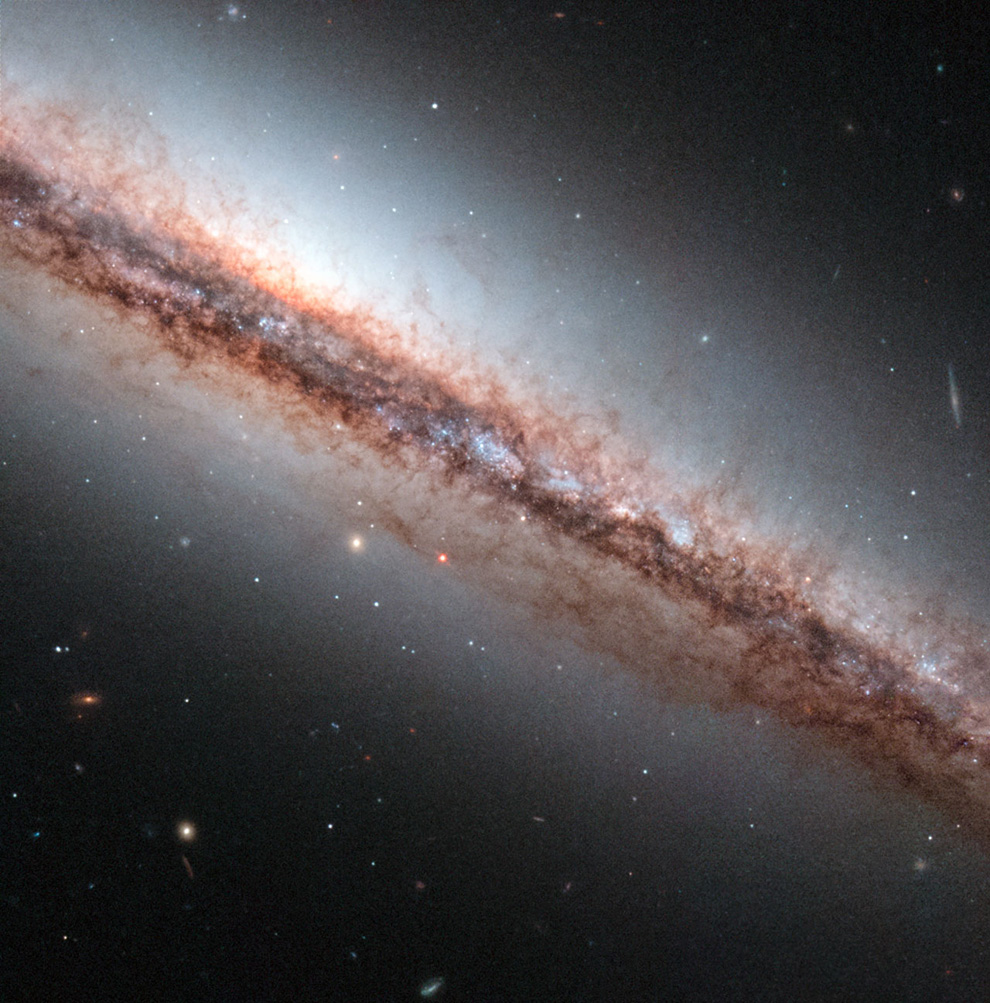
This is a stunning photograph of the central regions of the galaxy NGC 4217. This edge-on spiral galaxy is about 60 million light-years away. The image taken by the Hubble Space Telescope shows filaments of cosmic dust everywhere, obscuring the glow of stars from us. Some fibers are about 7,000 light years long! Photo: ESA/Hubble & NASA
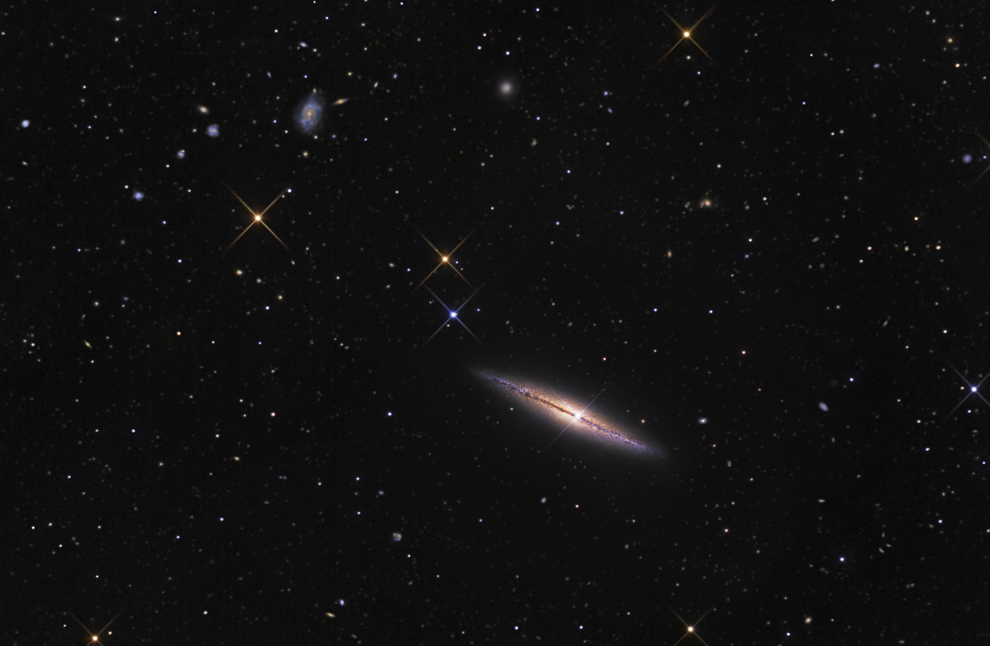
Galaxy NGC 4013. It is often called the Diamond Ring due to the star that shines at its center. This star, however, is part of the Milky Way and is much closer to us than NGC 4031. Photo: R. Jay GaBany
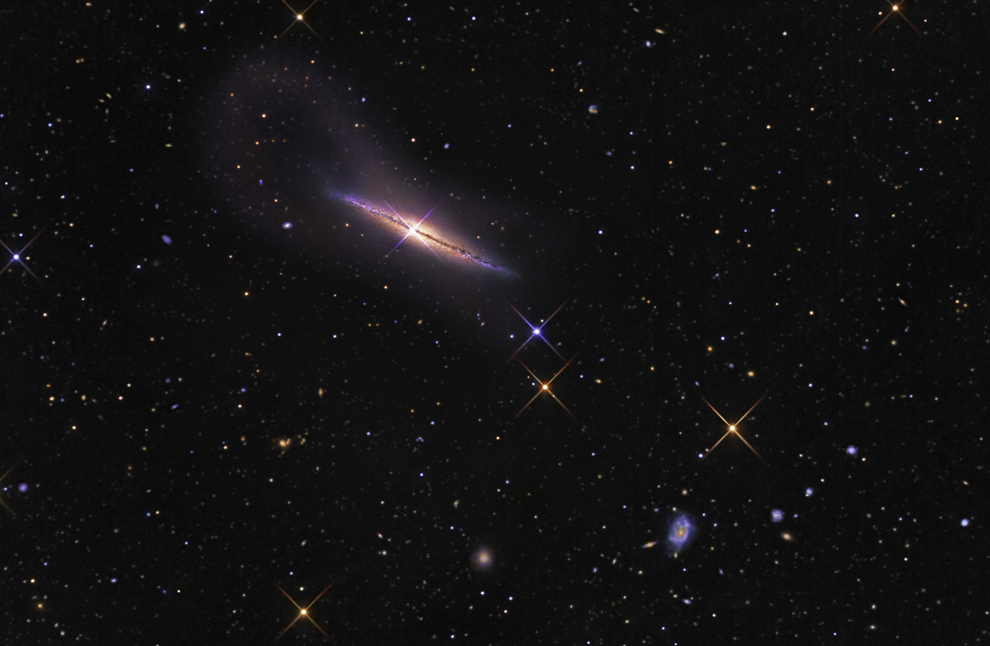
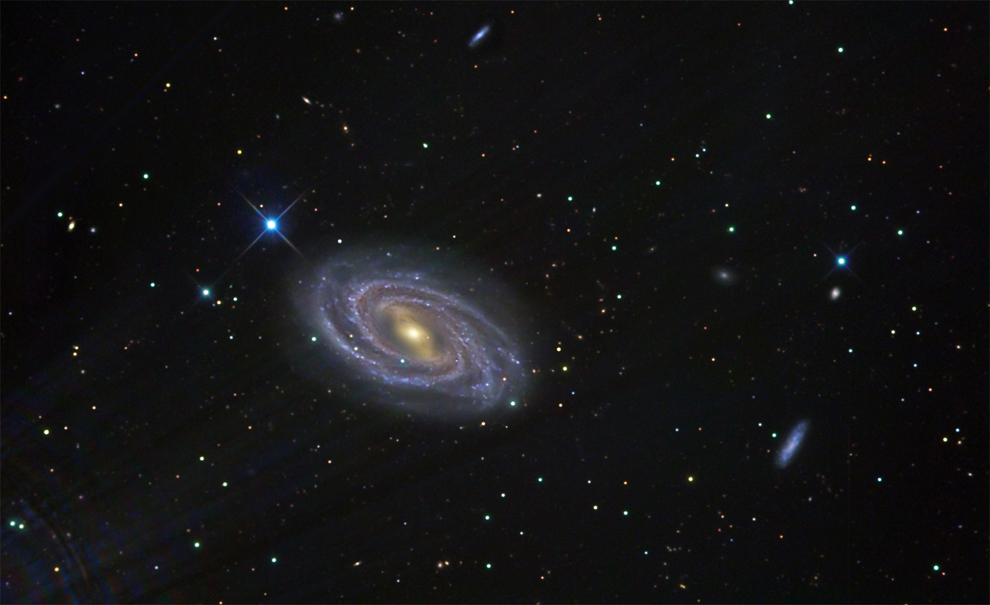
M109, one of the most bright galaxies in Ursa Major. In the sky it is located next to the star Phecda (gamma Ursa Major), one of the stars of the Big Dipper. Although Fekda was not included in the photo, the rays from her are clearly visible in the lower left corner of the photo. M109 is a typical barred spiral galaxy. The central regions of M109 are composed primarily of solar-type stars, and the spiral arms are formed by clusters of hot and young bluish-white stars. M109 is located 55 million light years from Earth and is part of a group of galaxies of the same name. Photo: R. Jay GaBany
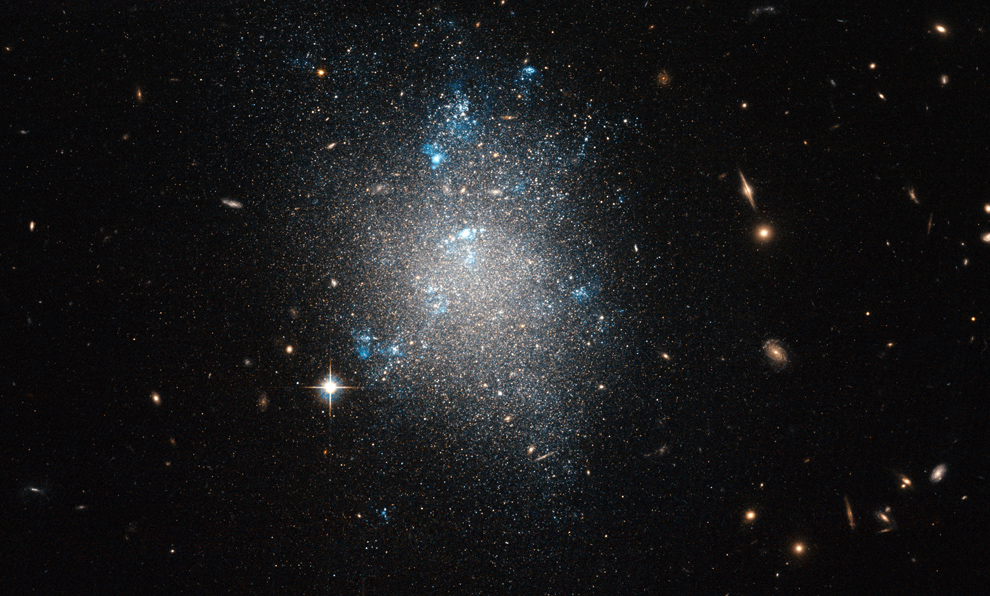
The constellation Ursa Major is home to not only classic spiral galaxies, but also dwarf galaxies like NGC 5477. This is a classic irregular dwarf galaxy - stars and nebulae are located in it chaotically and without structure. NGC 5477 is part of the M101 group of galaxies and is located at a distance of 20 million light years from us. Photo: ESA/Hubble & NASA
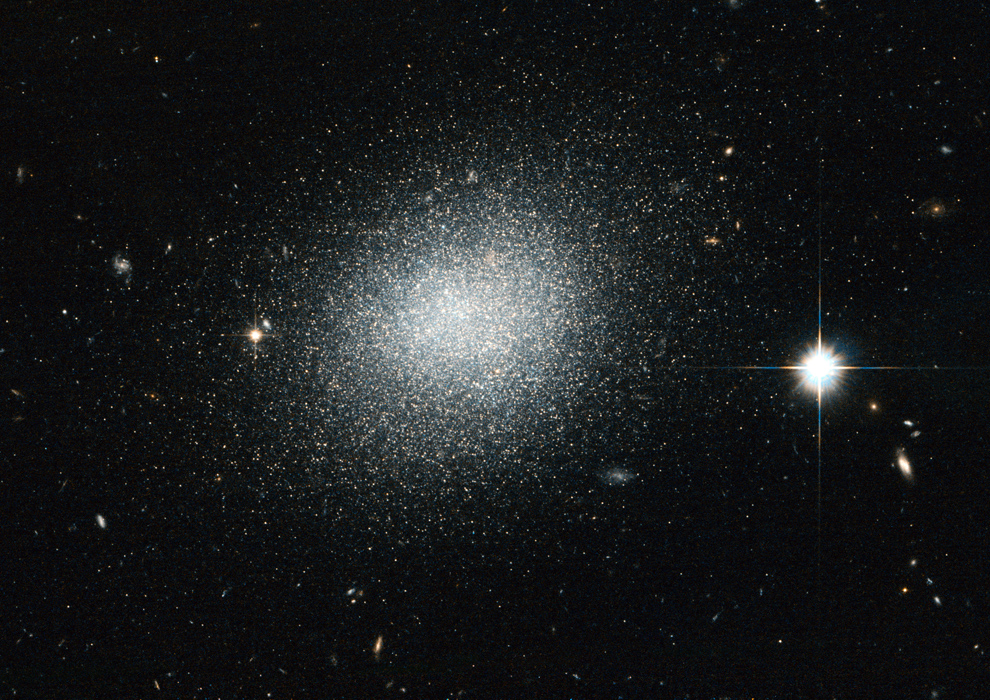
Another classic dwarf galaxy, UGC 5497, is located 11 million light years away and also in the constellation Ursa Major! Photo: ESA/Hubble & NASA
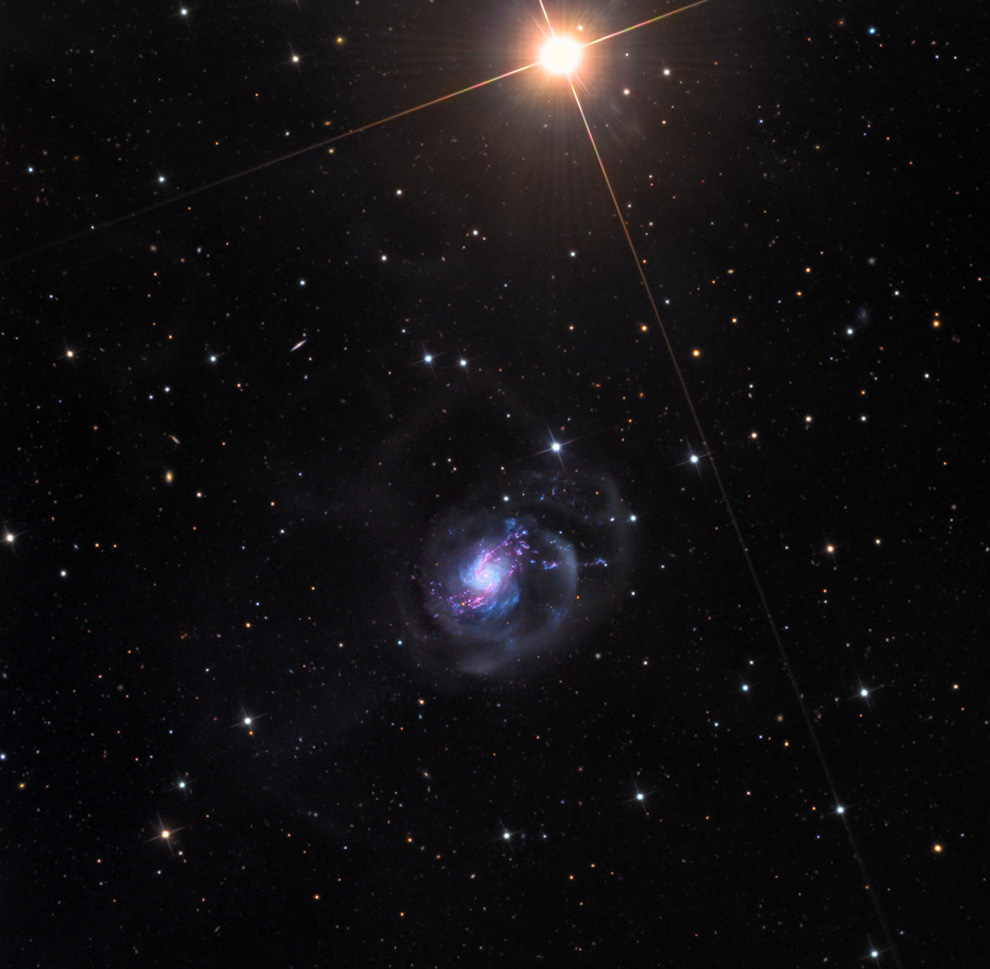
NGC 3310 is a starburst spiral galaxy. Located 50 million light years from Earth, this small one - with a diameter of 50,000 light years. years - the galaxy collided with another star system. This event, which occurred 100 million years ago, caused a sharp increase in star formation in it. Photo:
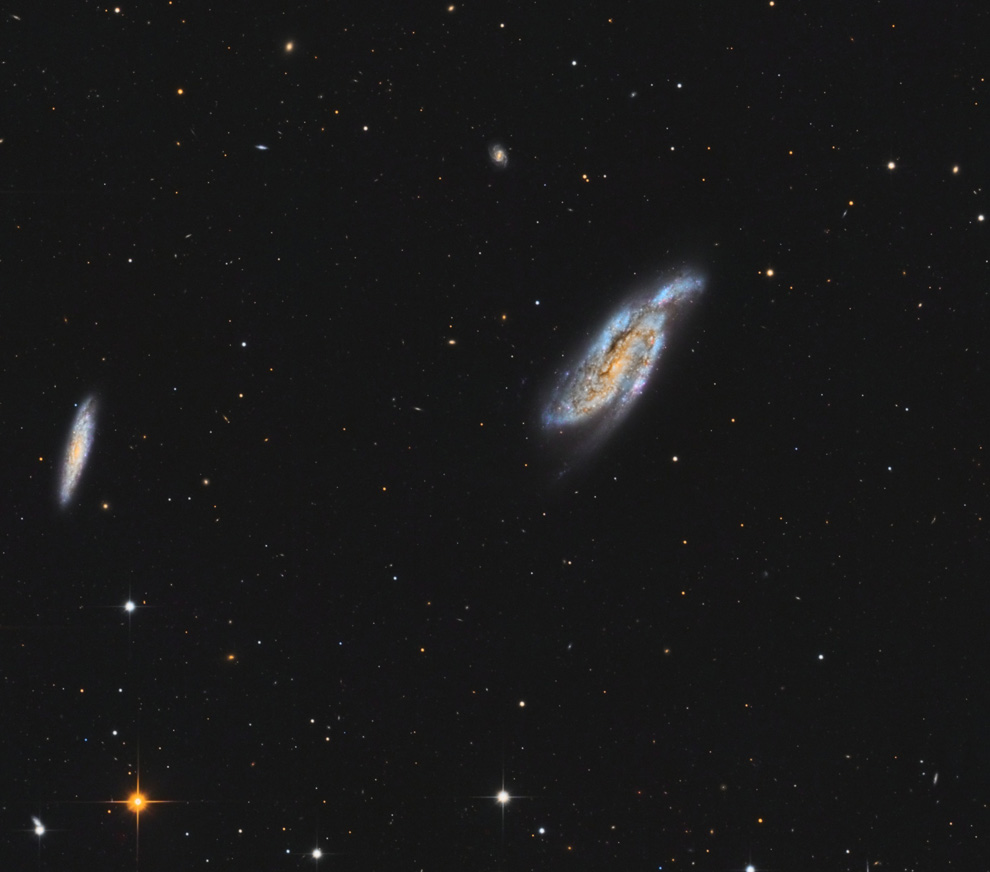
Another beautiful spiral in Ursa Major is the galaxy NGC 4088. Together with NGC 4085 (left) it forms a physical pair. The galaxy was discovered in 1788 by the famous English astronomer William Herschel; with a good amateur telescope, it is visible as a nebulous speck of 10 magnitude. Photo: Kai Wiechen
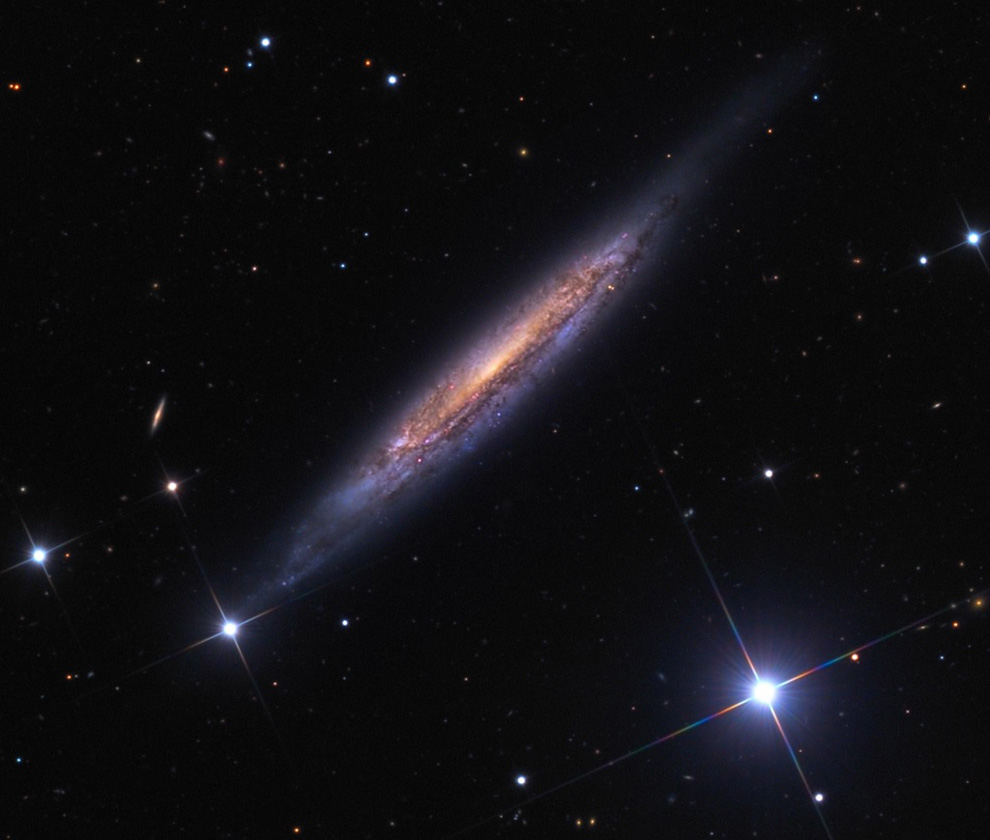
NGC 4157 in the constellation Ursa Major. This “island Universe,” as galaxies are sometimes called in popular books, is located 35.6 million light years away from us. The diameter of NGC 4157 is almost equal to the diameter of the Milky Way and is 105 thousand light years. The galaxy is a member of the Ursa Major galaxy cluster. Photo: Adam Block/Mount Lemmon SkyCenter/University of Arizona
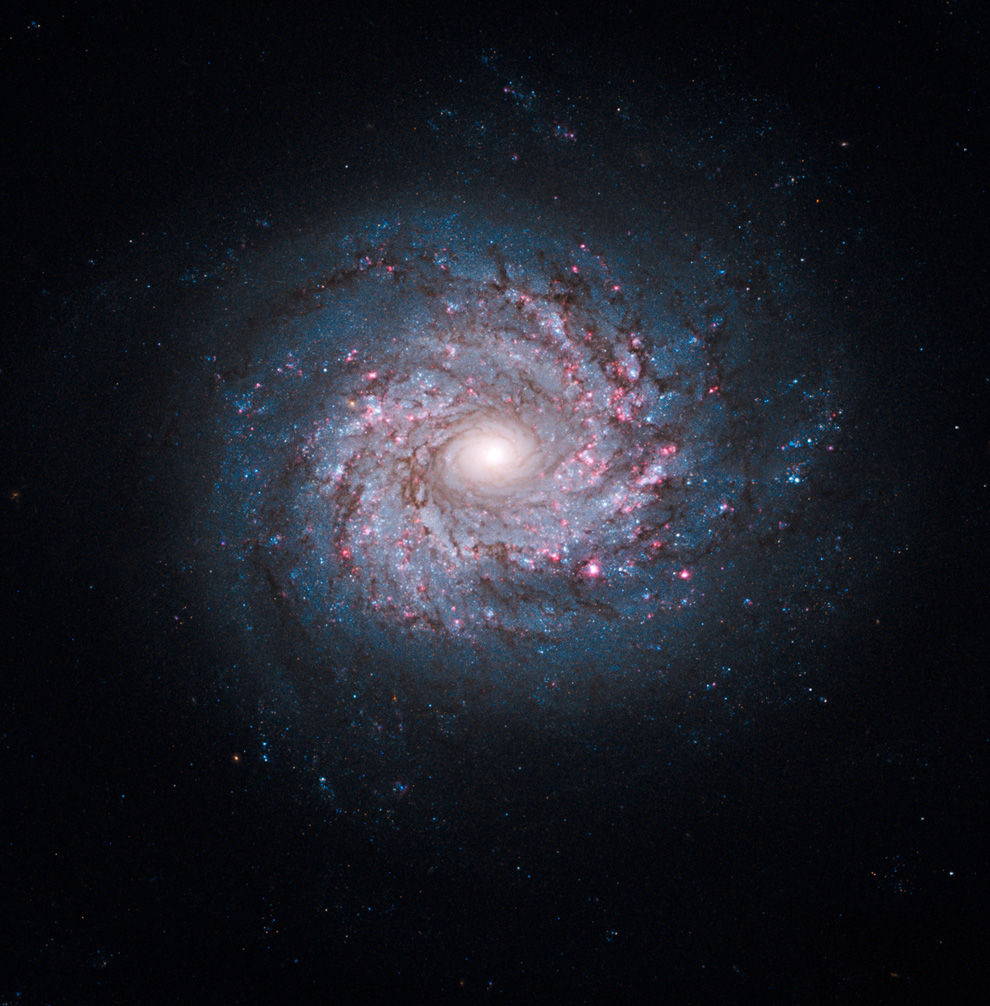
Miniature spiral NGC 3982. This beautiful galaxy is 68 million light-years from Earth and measures just 30,000 light-years in size—one-third the diameter of the Milky Way. The spiral arms of NGC 3982 form young star clusters and gaseous nebulae, in which active star formation processes take place. Photo: NASA/ESA/Hubble Heritage Team (STScI/AURA)
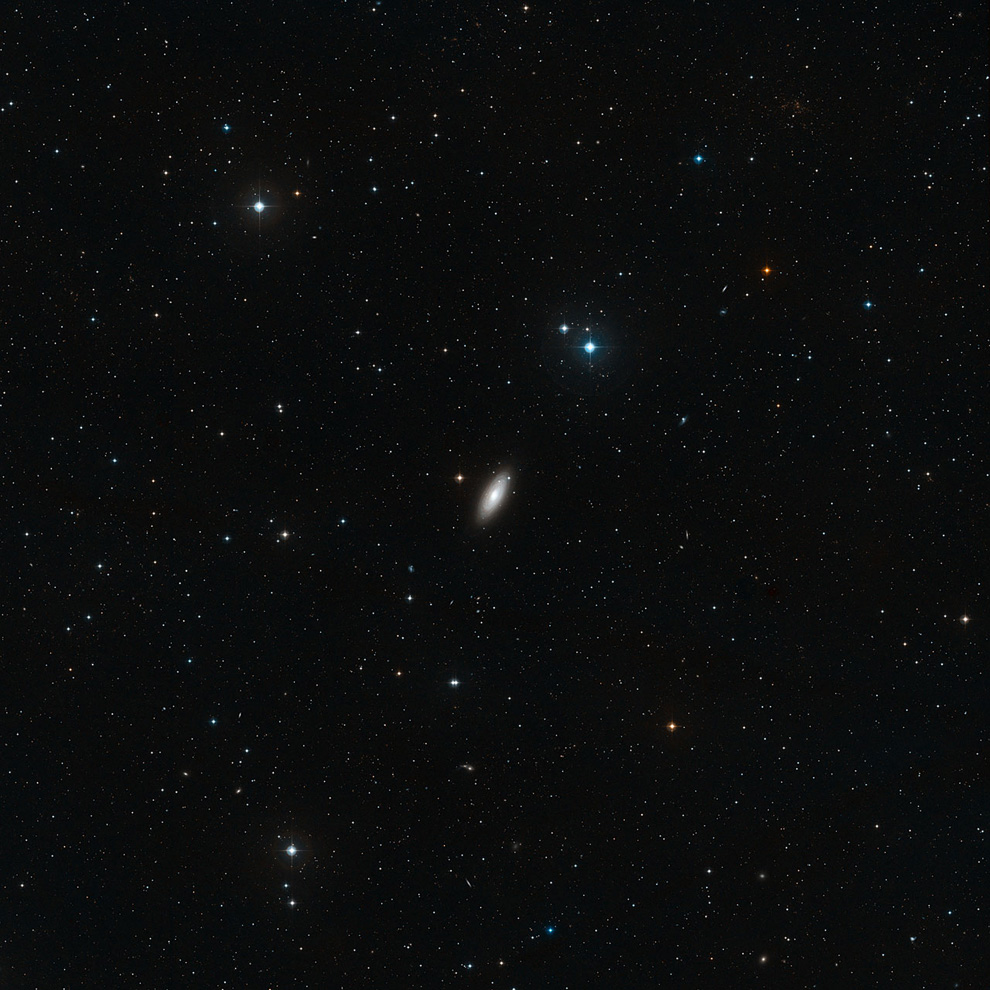
Galaxy NGC 2841, a classic spiral galaxy located in the constellation Ursa Major at a distance of 46 million light years from Earth. You can find it in amateur telescopes in a dark suburban sky 1.7 degrees from the star theta Ursa Major. NGC 2841 is one of the most massive and largest spiral galaxies in the Universe: its diameter is 150 thousand light years, which is almost 1.5 times the diameter of the Milky Way. Photo: NASA/ESA/Digitized Sky Survey 2
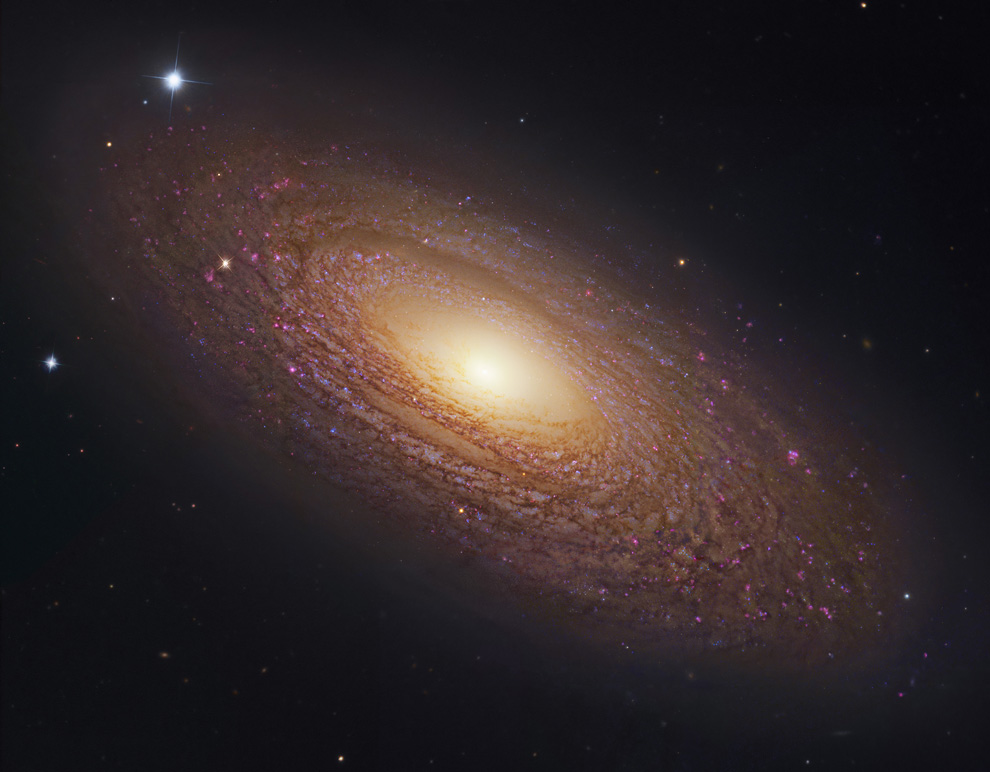
Galaxy NGC 2841 close-up. This clear image of the beautiful island universe clearly shows its yellow core and galactic disk. Hidden in the mottled, tightly wound spiral arms are dust lanes, small pink star-forming regions, and blue clusters of young stars. Unlike most spiral galaxies, which have broad arms, NGC 2841's spirals are not clearly defined; Astronomers call such galaxies flocculent spirals. Photo: NASA/Subaru/Robert Gendler/APOD
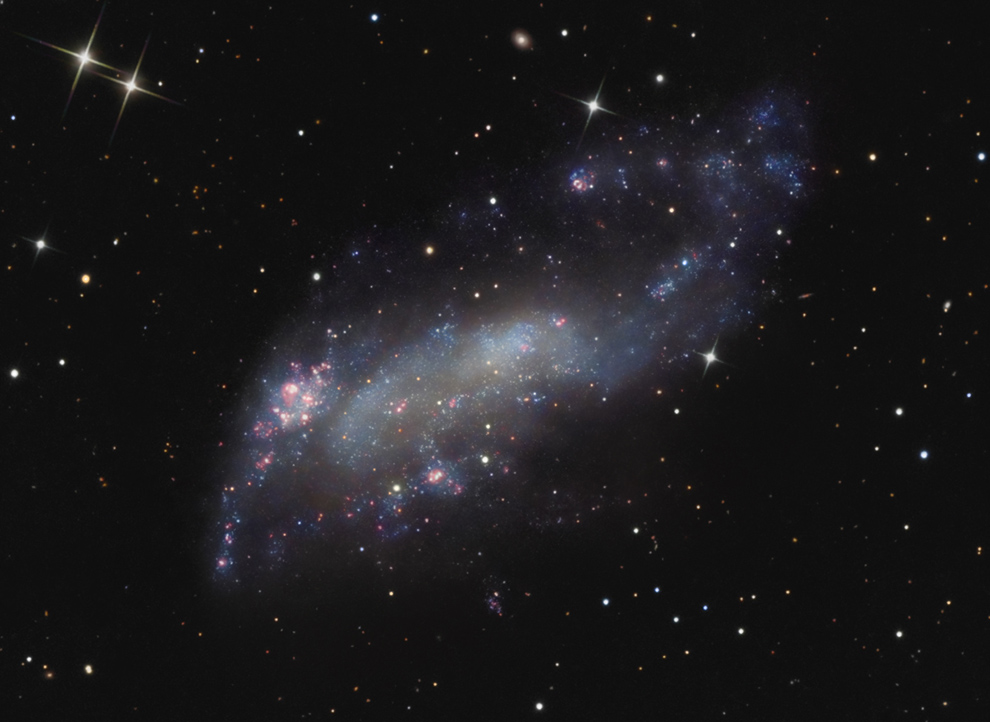
Galaxy IC 2574, better known as the Coddington Nebula. The galaxy was discovered on April 17, 1898 by Edwin Coddington at Lick Observatory. Despite its name, it is not a gas cloud, but an “island universe” like the Milky Way. Due to its high looseness and low surface brightness, the galaxy is usually classified as an irregular dwarf galaxy, but sometimes it is classified as a spiral galaxy star systems. Photo: Michael A. Siniscalchi
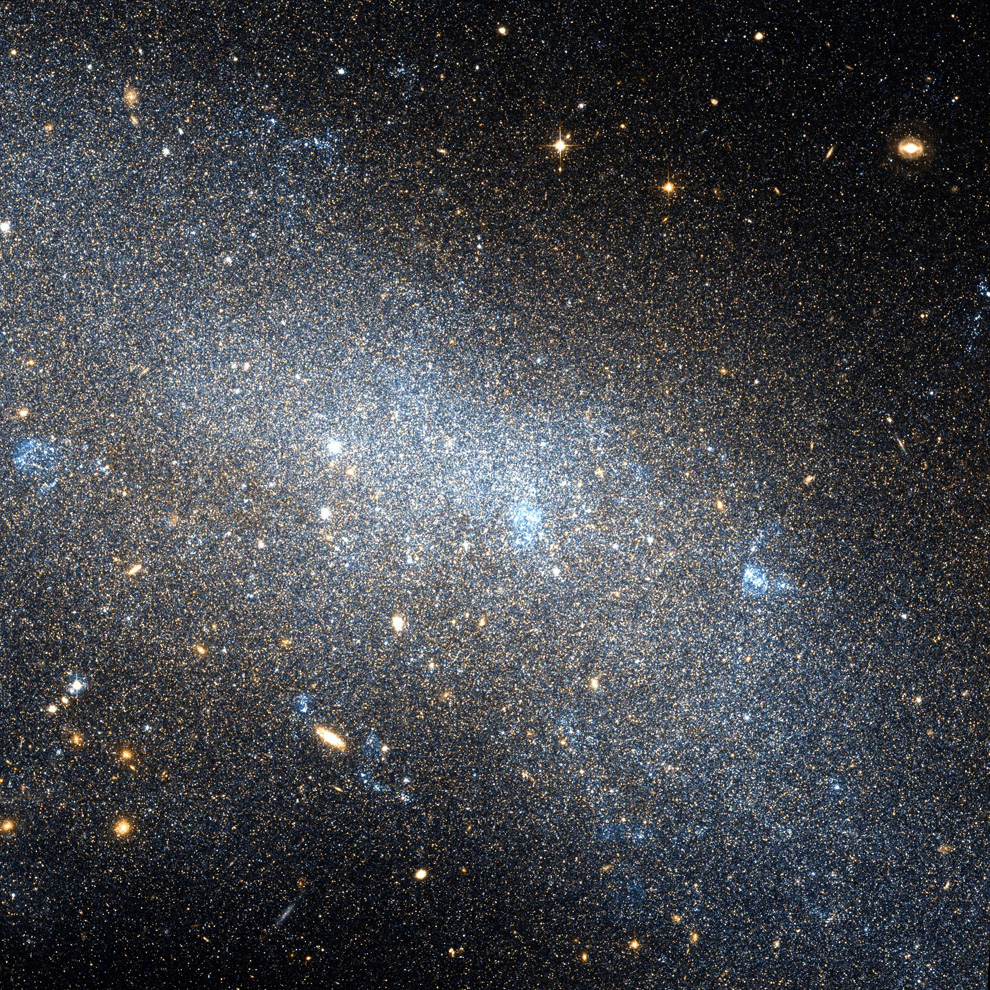
The distance to the Coddington Nebula is 12-13 million light years. It belongs to the M81 group of galaxies. In the world's largest telescopes, IC 2574 can be resolved into individual stars. This image, compiled from observations from the Hubble Space Telescope, shows the central regions of IC 2574, an area crowded with stars. Photo: Hubble/NASA
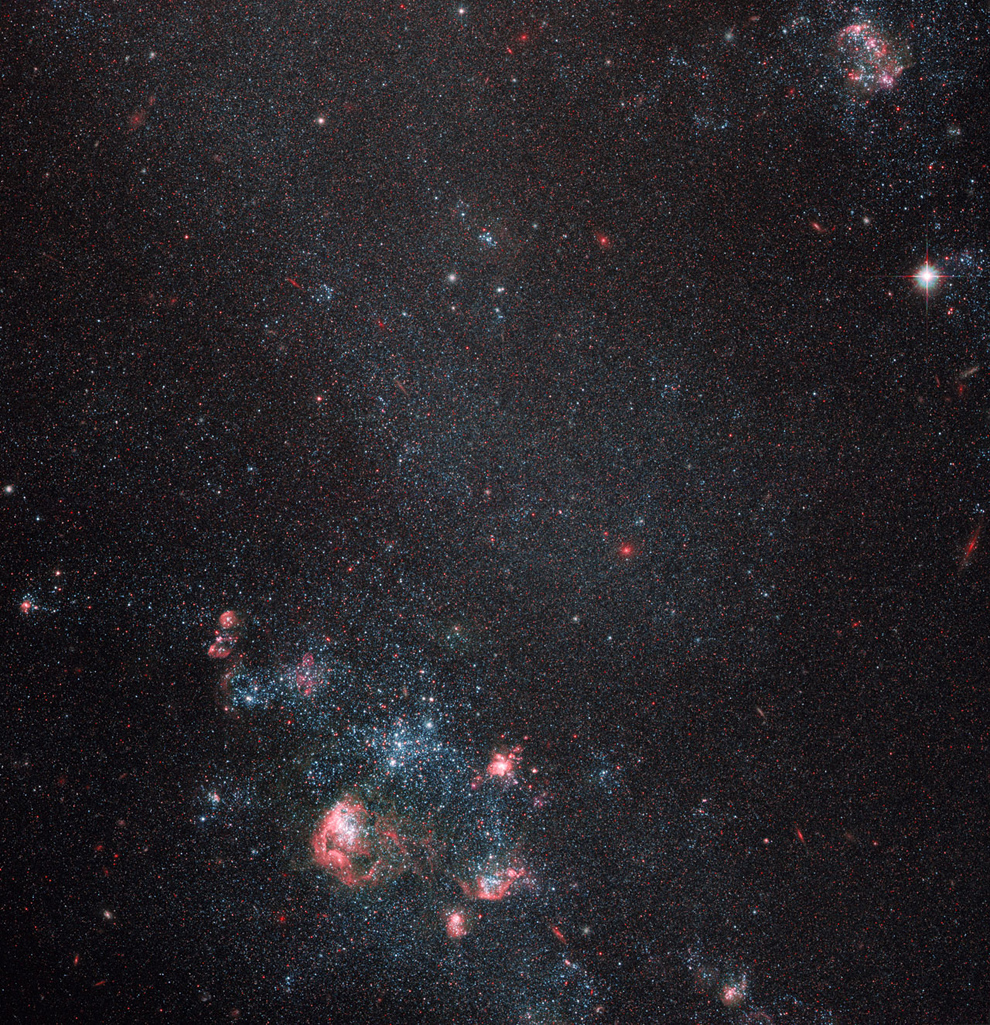
On the outskirts of the Coddington Nebula. Bright hydrogen nebulae resemble bubbles. This shape is not accidental: these are really gas bubbles, shock waves in interstellar matter, formed after supernova explosions. Hydrogen glows, heated by the powerful radiation from newborn stars inside nebulae. This is how dying stars contribute to the birth of new ones. Photo: ESA/Hubble & NASA
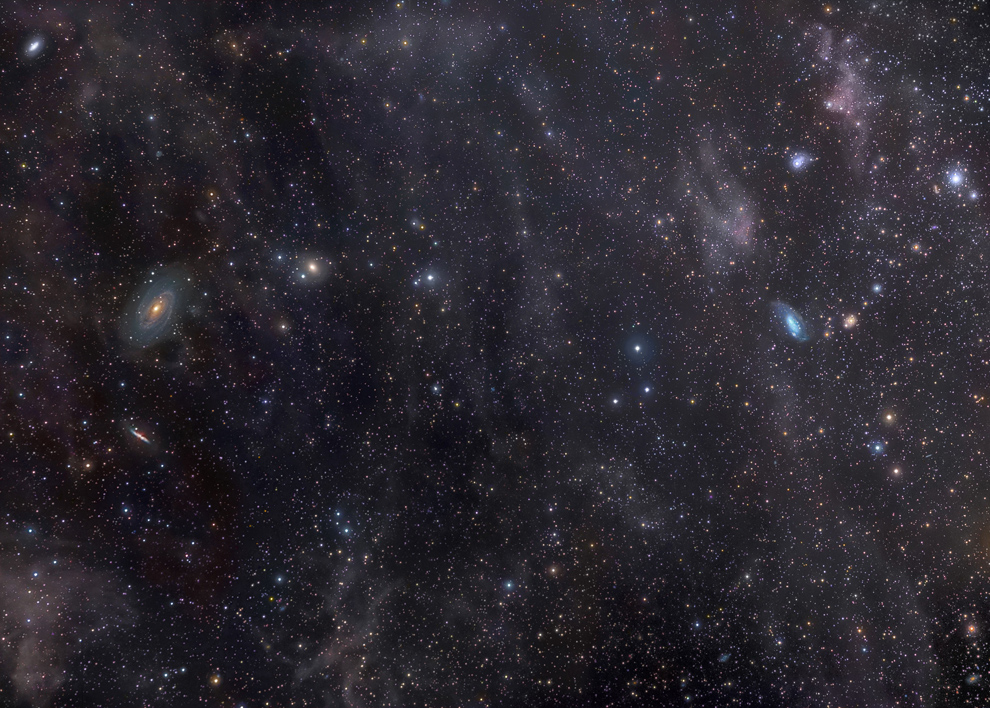
The Coddington Nebula (right) and a pair of galaxies M81 and M82 (left) against the background of galactic cirrus. Nebulae that look like a thin veil belong to the Milky Way; they float high above the galactic disk, far from the stars, and shine with the reflected light of all the stars in the Milky Way. The galaxies M81, M82 and IC 2574 are 10 thousand times further away. Photo: Wikisky.org/Rogelio Bernal Andreo
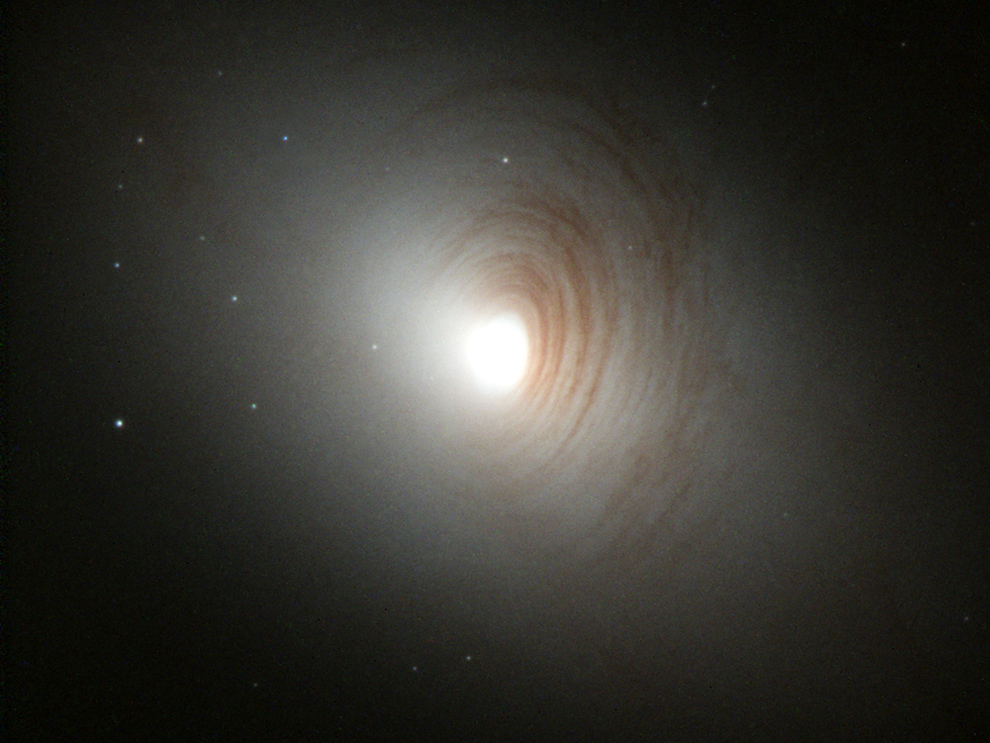
Densely wound, almost concentric, arms of dust surround the bright core of this otherwise inconspicuous lenticular galaxy NGC 2787. But for professionals, NGC 2787 is of considerable interest, since at its center there is a massive black hole. The galaxy is located 24 million light years from Earth in the constellation Ursa Major. Photo: NASA/ESA and The Hubble Heritage Team
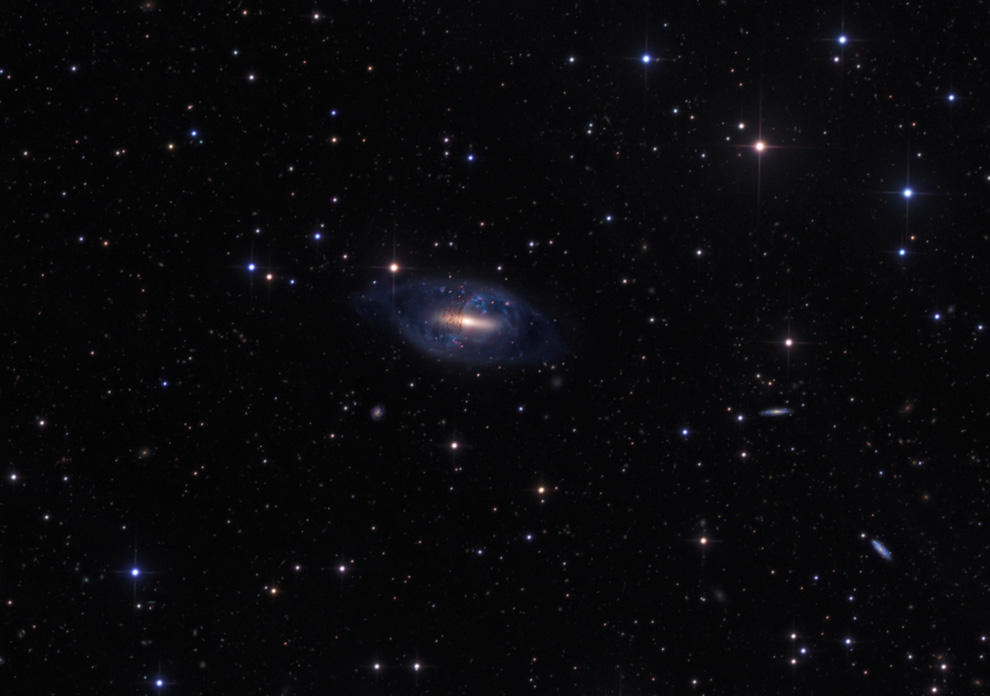
Another lenticular galaxy in Ursa Major, NGC 2685 or the Helix Galaxy, lies 40 million light-years from Earth in the constellation Ursa Major. Lenticular galaxies combine the features of spiral and elliptical galaxies, but NGC 2685, in addition, also has a polar ring. Note that in NGC 2685 some of the stars, gas and dust rotate in a ring perpendicular to the plane of the galactic disk. This strange shape could result from the accidental capture of matter from another galaxy by a disk galaxy, after which the captured matter is stretched into a rotating ring. However, the observed properties of NGC 2685 indicate that the ring around this galaxy is very old and stable. Photo: Ken Crawford
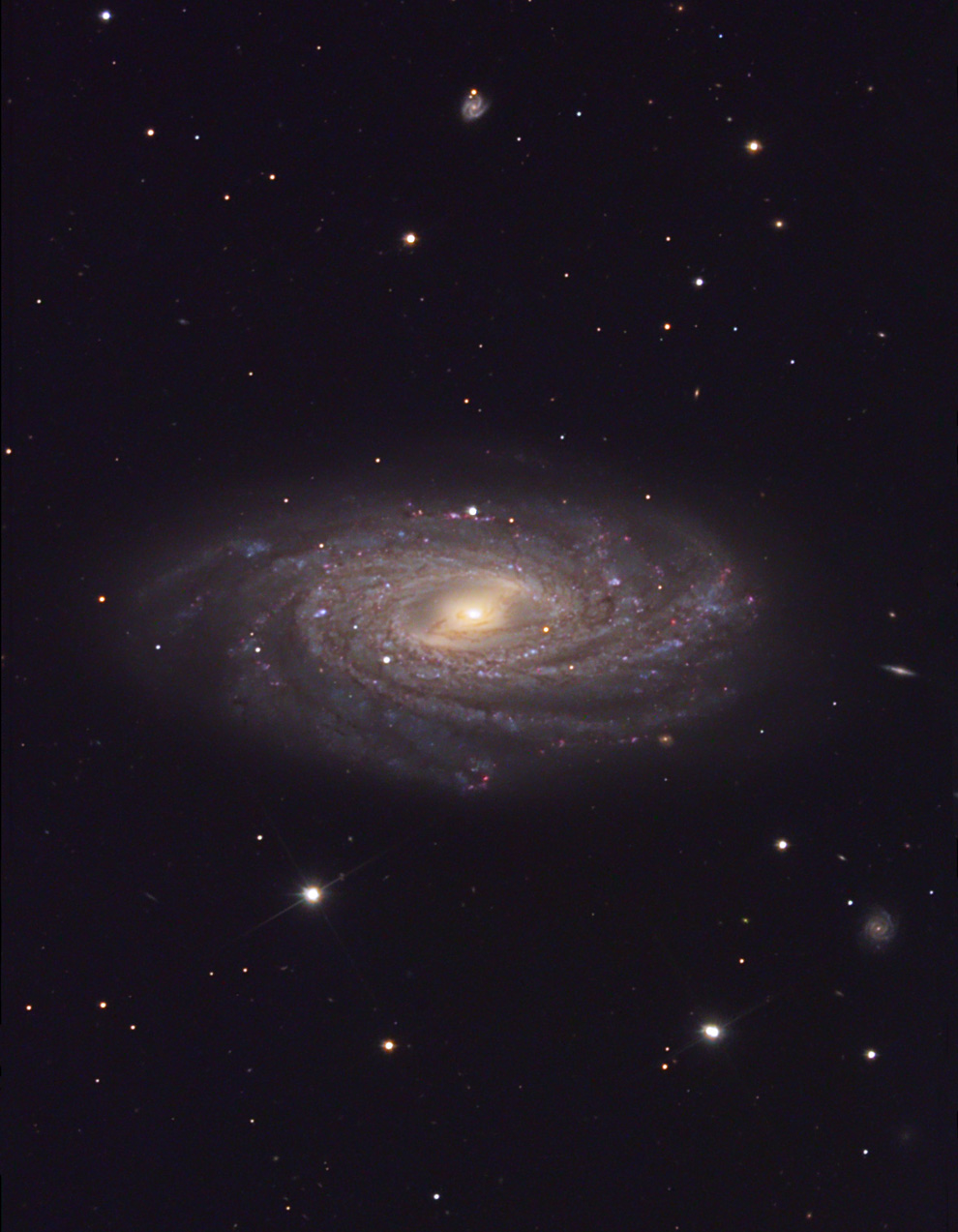
A nearly perfect spiral of galaxy NGC 3953. Note that the arms extend from the bar, not from the galactic core. Such spirals are called crossed. Photo: Tom Haynes/Adam Block/NOAO/AURA/NSF

Nearby spiral galaxy NGC 2976 from the M81 group of galaxies. Located 11.6 million light-years from Earth, this small galaxy has a distinct bluish color, a result of its abundance of massive, hot stars. Photo: Salvatore Iovene

A detailed image of the outskirts of NGC 2976 taken by the Hubble Space Telescope. Like regular spirals, NGC 2976 has a flat disk, but it does not have pronounced spiral arms. Gravitational interaction with neighboring galaxies led to an outbreak of star formation, which began about 500 million years ago. In the picture we see the consequences of this outbreak: almost all of the interstellar gas is spent on the stars that overwhelm the frame. Photo: NASA, ESA, and J. Dalcanton and B. Williams (University of Washington, Seattle)

But here is an object that is practically inaccessible to amateur telescopes: the distant interacting galaxy Arp 194. In this image obtained using Hubble telescope, several galaxies are depicted exchanging matter. Particularly impressive is the fountain of stars, gas and dust stretching over 100,000 light years. Blue spots are superclusters of bright blue stars, whose birth was a direct consequence of the collision of galaxies and the compaction of gas in them. The galaxy group is designated Arp 194 in the catalog of peculiar galaxies compiled by astronomer Halton Arp. Photo: NASA, ESA and the Hubble Heritage Team (STScI/AURA)

Another pair of interacting galaxies in Ursa Major, which we observe after a collision. The two spiral galaxies that make up the pair Arp 148 experienced a head-on collision several tens of millions of years ago. As a result, the galaxy that we see from the front has turned into a ring without central core, the second galaxy was elongated by tidal forces. Arp 148 is located 500 million light years from Earth in the constellation Ursa Major. Photo: NASA, ESA, the Hubble Heritage Team (STScI/AURA)

The unusual galaxy I Zwicky 18 was originally classified as a dwarf irregular galaxy, much smaller in size than the Milky Way. However, modern research shows that this is a large and distant island Universe, located at a distance of about 60 million light years! Its shape was distorted due to gravitational interaction with the neighboring galaxy, which is located in the image above. Shock waves in the galaxy led to a burst of star formation; Numerous hot and very young stars blew gas out of Zwicky 18, forming a huge glowing bubble around it. Photo: NASA, ESA, and A. Aloisi (European Space Agency and Space Telescope Science Institute)

Galaxy NGC 3079, another large spiral in the constellation Ursa Major. It is located 50 million light-years from Earth and looks as impressive optically as it does in the combined images (see next image). Photo: Robert Gendler

NGC 3079 appears in all its majesty in this image from the Hubble Space Telescope. Noteworthy are the giant filaments flying out from the core of the galaxy. As with the M82 galaxy, NGC 3079's filaments are generated by stellar winds that blow gas out of the galactic plane. The fibers are 2000 light years long and 75 light years thick! Their speed is 6 million kilometers per hour! Photo: NASA/Hubble

Hubble's first ultra-deep field photographed in 1995. This image captures about 1,500 galaxies, many of which are billions of light years away! It is amazing that all these star islands fit on a tiny piece of sky the size of a grain of rice at arm's length. Almost everything you see in this exciting image is galaxies. Photo: R. Williams (STScI), the Hubble Deep Field Team and NASA/ESA

Dwarf galaxy NGC 5474 in the constellation Ursa Major. The word “dwarf” should not be misleading - this galaxy includes several billion stars! NGC 5474 is part of the M101 group of galaxies and is located at a distance of 20 million light years from Earth. Photo: ESA/Hubble & NASA

Like ice skaters, two galaxies dance around under the influence of gravity, losing their matter. Stars, gas and dust formed a giant bridge between their neighbors, and the outer regions of the galaxies became twisted tidal tails. The galaxies have one designation - UGC 8335 (or Arp 238) - and are located in the constellation Ursa Major at a distance of 400 million light years from Earth. Photo: NASA, ESA, the Hubble Heritage Team (STScI/AURA)-ESA/Hubble Collaboration and A. Evans (University of Virginia, Charlottesville/NRAO/Stony Brook University)

What is this handful of grains of sand-stars scattered across the picture? This is a dwarf galaxy UGC 4459, located in the constellation Ursa Major at a distance of 11 million light years from Earth. Despite his modest appearance, in this tiny island universe there are active star formation processes. See huge bubbles of interstellar hydrogen glow as they glow under the ultraviolet light of hot stars. Incredibly beautiful! Photo: ESA/Hubble & NASA

There are countless spiral galaxies in the constellation Ursa Major. Here's another one, NGC 3675. Photo: Adam Block/Mount Lemmon SkyCenter/University of Arizona

Galaxy NGC 4102 in the constellation Ursa Major. Photo: ESA/Hubble, NASA and S. Smartt (Queen's University Belfast
![]()
Galaxy NGC 3642 looks like a celestial whirlpool. Unlike crossed spirals, the arms of this galaxy extend not from the bridge, but directly from the core. The spirals of NGC 3642 are very tightly twisted and it’s hard to even figure out how many arms it actually has? Photo: Adam Block/Mount Lemmon SkyCenter/University of Arizona

Spiral galaxies NGC 3718, NGC 3729 and the Hickson 56 group. The pair NGC 3718 and NGC 3729 are located at a distance of 56 million light years from Earth - the Hickson 56 group of galaxies is several times further away. This group consists of 5 distant galaxies located adjacent to the beautiful crossed spiral NGC 3718. Hickson 56 is a very difficult object to observe for amateurs, but look how cool they appear in this photo! Thanks to Oleg Bryzgalov. Photo: Oleg Bryzgalov
